|
Battle of Gettysburg
Pennsylvania and Civil War
Battle of Gettysburg
Gettysburg Civil War History
Other Names: None
Campaign(s): Gettysburg Campaign (June-July 1863); Lee's Invasion
of the North (June-July 1863)
Date(s): July 1-3, 1863
Estimated Casualties: 51,000 total (US 23,000; CS 28,000)
Result(s): Union Victory
Summary: Having concentrated his army around the small town of Gettysburg, Pennsylvania,
Gen. Robert E. Lee awaited the approach of Union Gen. George G. Meade’s forces. On July 1, early Union success faltered
as Confederates pushed back against the Iron Brigade and exploited a weak Federal line at Barlow’s Knoll. The following
day saw Lee strike the Union flanks, leading to heavy battle at Devil's Den, Little Round Top, the Wheatfield, Peach Orchard,
Culp’s Hill and East Cemetery Hill. Southerners captured Devil’s Den and the Peach Orchard, but ultimately failed
to dislodge the Union defenders. On the final day, July 3rd, fighting raged at Culp’s Hill with the Union regaining
its lost ground. After being cut down by a massive artillery bombardment in the afternoon, Lee attacked the Union center on
Cemetery Ridge and was repulsed in what is now known as Pickett’s Charge. Lee's second invasion of the North had failed,
and had resulted in heavy casualties; an estimated 51,000 soldiers were killed, wounded, captured, or listed as missing after
Gettysburg.
| Official Battle of Gettysburg Map |
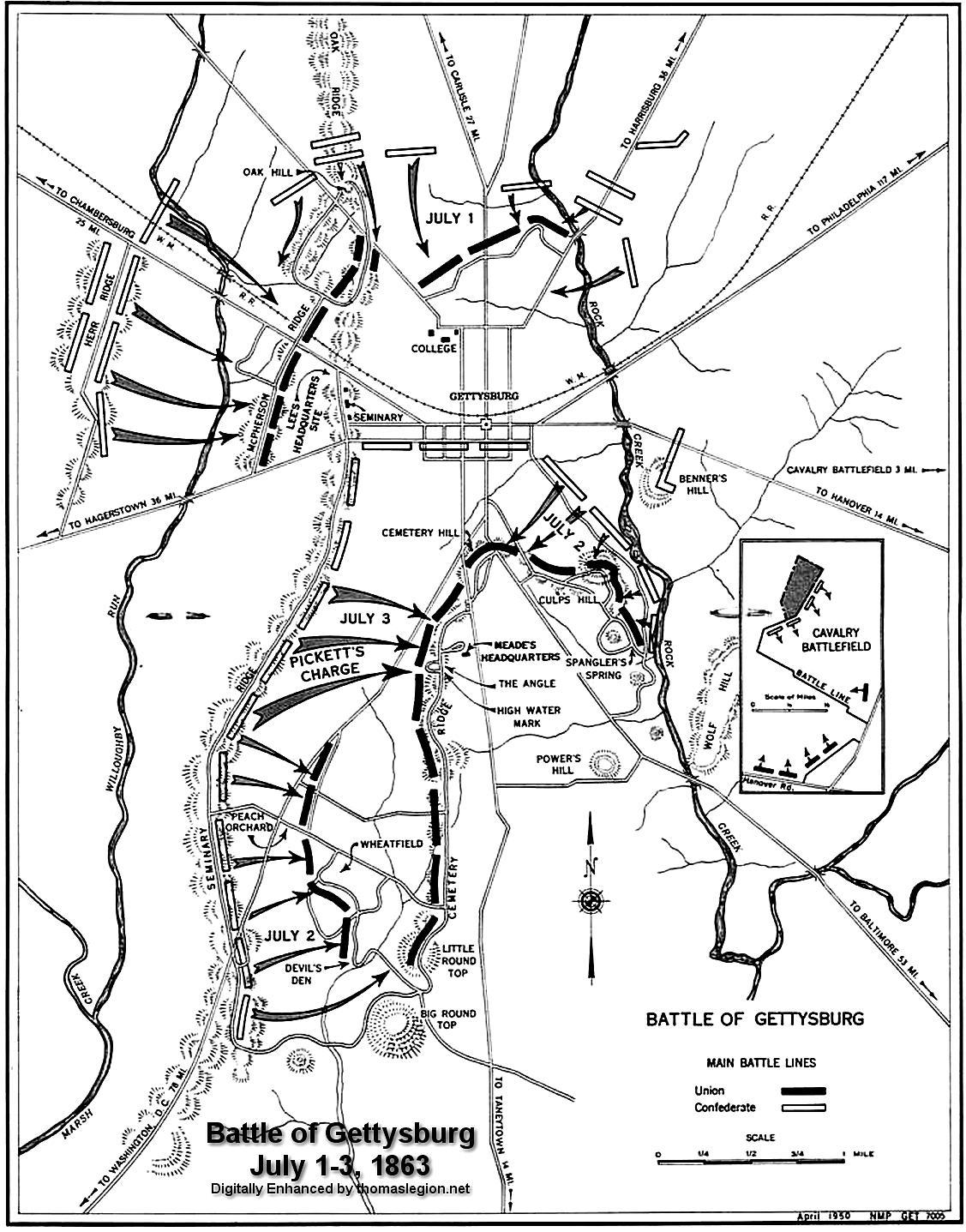
|
| Battle of Gettysburg, July 1-3, 1863 |
Battle of Gettysburg and Civil War
July 1, 1863 - "The Battle of Gettysburg Begins"
The first day's fighting at the battle of Gettysburg (at McPherson’s
Ridge, Oak Hill, Oak Ridge, Seminary Ridge, Barlow’s Knoll and in and around the town) involved some 50,000 soldiers
of which roughly 15,500 were killed, wounded, captured or missing. The initial day in itself ranks as the 12th bloodiest battle
of the Civil War.
On the morning of June 30, during the Gettysburg Campaign, a Confederate column under Brigadier General James J. Pettigrew approached
Gettysburg on the Chambersburg Road. Halting his men outside of town, the general rode
ahead to Seminary Ridge from which he had a clear view of Gettysburg and the land around it. Within
a few minutes he was startled by the report of a blue-clad column approaching Gettysburg
from the south. Were these men just more bothersome Yankee militia or troopers
from their old nemesis the Army of the Potomac? Under strict orders not to engage in
any fighting, he ordered his troops, attached to Lee's Army of Northern Virginia, to reverse their course, back toward Cashtown, Pennsylvania. What to do about this column of soldiers would be the decision of his corps commander, General A.P. Hill to
whom Pettigrew would report that afternoon.
| John Buford |

|
| (U.S.A.M.H.I.) |
The commander of the mystery column was Brig. General John Buford, whose troops were not "Yankee militia"
but a full division of veteran cavalry. His horsemen were the advance of one wing of the Army of the Potomac, moving north
from the vicinity of Frederick, Maryland. General Buford also had unanswered questions as he watched the Southern column march
away- had they found what may be a large portion of the Confederate army then raiding south-central Pennsylvania? Buford's
instinct told him these Confederates would return and he decided to keep his troops positioned around Gettysburg. Headquarters
were soon established in the Globe Hotel in Gettysburg, where Buford issued orders for his troopers to picket the roads west,
north and east of town. He then penned a message to General John Reynolds, commander of the First Corps, camped at Marsh Creek
eight miles south of Gettysburg. Reynolds received the report, which outlined Buford's intention of resisting any Southern
advance toward Gettysburg. Reynolds replied that he would march to the cavalry officer's support at first light.
Meanwhile, Confederate commanders met at Cashtown eight miles west of Gettysburg,
to discuss their course of action. Under orders from General Lee not to get involved in a full scale battle, Hill and his
officers obviously believed that only troublesome militia was in their way. General Hill received Pettigrew's report of his
encounter and decided to send a larger force toward Gettysburg the next day to investigate the Union troops seen there and,
if time allowed, look for supplies. Showers and light rain that evening would also help keep down the dust and dirt on the
roads, making for a pleasant march.
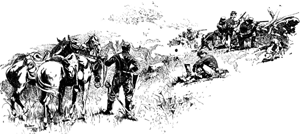
Lt. Marcellus Jones of the 8th Illinois Cavalry was in charge of a picket line that intersected the Chambersburg
Road three miles west of Gettysburg. Dawn was just breaking on the morning of July 1, 1863, when, in the distance, cavalrymen
in the main post on the road could discern the sound of hushed conversations, the clink of metal cups and canteens, and the
shuffle of boots and shoes on the road surface. A sergeant ran to find Lt. Jones, who had just returned to the reserve position
with bread and butter purchased from a nearby farm. Jones immediately rode with the sergeant to the post and peering through
the early morning haze, he spotted a gray column of soldiers, lazily swinging down the road toward him. Borrowing a carbine
from his sergeant, the lieutenant took aim at a mounted figure in front of the column and fired. The column abruptly stopped
and the horseman pointed out the Yankee picket post. Behind him, a wisp of wind revealed a red banner. There was no doubt
that these men were- Confederates! Jones handed a brief message to a courier, instructing him to ride as fast as possible
to General Buford. Seconds later a cannon ball bounded down the road, scattering the Union troopers as Southern bullets whined
overhead. The Battle of Gettysburg had begun.
| Gen. Henry Heth |
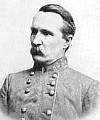
|
| (Miller's History) |
The Southerners spotted by Jones' picket post were veteran troops of Major General Henry Heth's division,
leading the march toward Gettysburg that morning. Well-liked by General Lee, (Heth was the only Confederate officer Lee addressed
by his first name), the plucky general was uncertain of what lay ahead of him, be it Pennsylvania militia or troops from the
Army of the Potomac, so he ordered his lead unit to deploy in a skirmish line and drive away the blue-clad troopers. The job
was given to the 5th Alabama Infantry Battalion, which advanced in good order and quickly encountered groups of cavalrymen
who fired on them from the protection of fences and trees. Three miles away at Gettysburg, General Buford calmly awaited the
report knowing full well that a thin line of cavalrymen were no match against solid ranks of infantry. Though Reynolds' corps
had started toward town that morning, Buford had to wonder if they would arrive in time before he was forced to retreat.
| The McPherson Farm and ridge. |
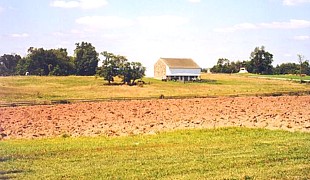
|
| (Gettysburg NMP) |
The skirmishing continued for over an hour, the troops passing over a series of rolling ridges farm fields
until Buford's men reached Willoughby Run, a shallow stream that bordered the Edward McPherson Farm on the Chambersburg Pike. Through the center of the farm is north-south ridge that lies parallel to the run,
and was a good position from which to cover the bridge that spans it. From the observatory of the Lutheran Seminary on Seminary
Ridge, Buford watched his horsemen gather on McPherson's Ridge and knew that time was running out. His men had been lucky up to this point- the Confederates had only advanced
as skirmishers and not pushed forward in solid battle lines. But Southern pressure was steadily growing and the clouds of
dust rising from the pike were an obvious sign of more Confederates troops moving toward Gettysburg.
(Left) McPherson's Ridge.
Confederate artillery was just then pulling into line on Herr's Ridge west of Willoughby Run, which meant
the Confederate commander was done with skirmishing and an infantry attack was sure to follow. General Heth had indeed discovered
how slender the Union line was and having arrived at Herr's Ridge, decided it to be the perfect point from which to launch
an attack and drive away these pesky Union soldiers once and for all. With his artillery unlimbered and ready to fire, Heth
ordered his two lead infantry brigades under Brig. General James Archer and Brig. General Joseph Davis to go forward. With
red battle flags unfurled, Archer's and Davis' Confederates set out toward McPherson's Ridge.
| John F. Reynolds |

|
| (Miller's History) |
| James Archer |

|
| (Miller's History) |
From his post in the observatory of the Seminary roof, General Buford was intently observing the fighting
when he was startled by a familiar voice calling from below: "How goes it, John?" Buford
immediately recognized his old friend Reynolds. "The devil's to pay!" he replied, and rushed down to meet with the infantry
commander. The two officers quickly discussed the situation and rode together to McPherson's Ridge. Reynolds chose the ridge
as the best location to establish an artillery and infantry battle line, but Southern pressure on Buford's men was mounting
and Reynolds knew his men would have to move fast. With a casual salute, Reynolds rode off to hurry his troops forward. It
was the last time Buford would see the general alive.
Within a half-hour, the vanguard of Reynolds' corps arrived near the Seminary and moved toward the McPherson
Farm, while more soldiers filed into the field west of the school building. By this time, the advance of General Archer's
brigade had reached the woods and field south of McPherson's farm and turned their attention to the blue-clad infantry forming
in their front. This was the famous "Iron Brigade", which had won its reputation on the battlefields of Second Manassas, Antietam, and Fredericksburg, and was commanded by Brigadier General Solomon Meredith. Meredith had just ordered the
first regiment of the brigade, the 2nd Wisconsin Infantry, to deploy into battle line when the first volley from Archer's
men struck them from the edge of the woods. The black-hatted Wisconsin soldiers had not even had a chance to load their rifles,
but with bayonets fixed and little more encouragement required, the 2nd Wisconsin lunged into the woods. Caught off guard
by the sudden counterattack, the Confederates fired a few scattered shots and then retreated in disorder through the woods
and across Willoughby Run, with the Union soldiers in hot pursuit. A number of Southerners found themselves cut off and were
taken prisoner including General Archer, grappled from the Southern ranks by Private Patrick Maloney of the 2nd Wisconsin
Infantry.
| Battle of Gettysburg, July 1, 1863 |
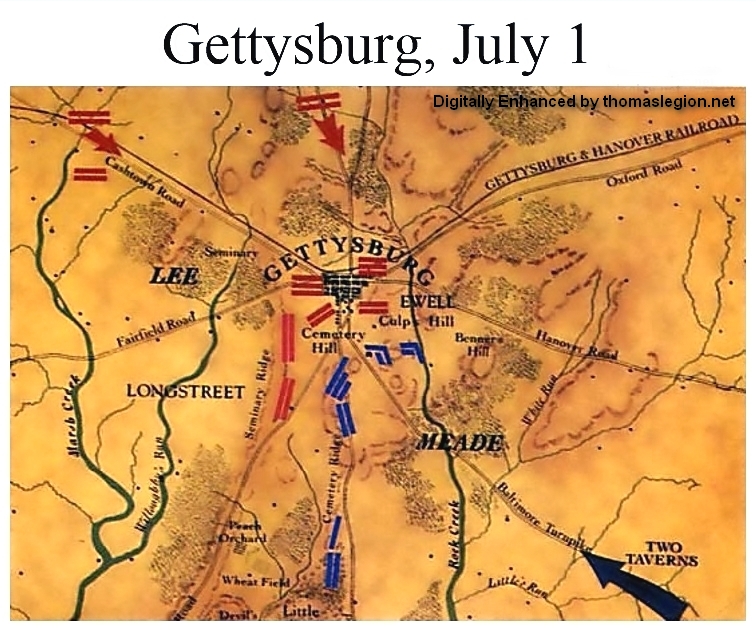
|
| First Day at Battle of Gettysburg |
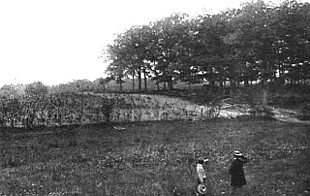
|
| (Brady Collection, Library of Congress) |
(Left) Brady photo of a guide who points to the site where General Reynolds was killed in the
woods that border the McPherson Farm. Seminary Ridge is in the background. Mathew Brady is credited as the father of photojournalism.
Although many Civil War photos are attributed to Brady, he in fact took few photos, mostly of high ranking officers and politicians.
The majority of the snapshots of the conflict were taken by those in Brady's employment.
Riding behind the 2nd Wisconsin, General Reynolds cheered the men on as they scrambled into the woods. The
general turned toward Seminary Ridge to see what troops and officers were following, when he suddenly slumped in his saddle.
A staff officer rushed to the general's side as he toppled from his horse. Cradling the general, the officer felt blood on
the back of Reynolds' head and turning him over saw that a bullet had cleanly struck the general in the right temple, killing
him instantly. John Reynolds was the highest ranking officer of either side to lose his life at Gettysburg
and was the general who had recommended General Meade to replace General Hooker in command of the Army of the Potomac. The general's body was borne from the field
in an ambulance, escorted by his heartbroken staff officers. He was buried in his hometown of Lancaster, Pennsylvania, barely
40 miles away from the battleground where he had lost his life.
Fighting also erupted in fields north of the McPherson Farm, where Davis' Brigade of Mississippi and North
Carolina regiments routed part of General Lysander Cutler's Union brigade. When success seemed within their grasp, Davis'
regiments were thrown back in confusion by a rapid Union infantry charge and accurate artillery fire.
| Rufus Dawes |

|
| (State of WI) |
| Fighting began that morning west of Gettysburg. |
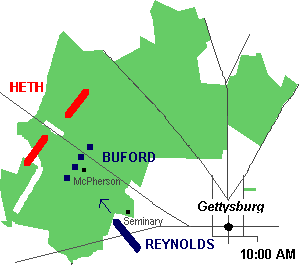
|
| By late afternoon, the Union was in retreat. |
Taking refuge in the bed of an unfinished railroad, Davis' troops desperately fought back as Union troops
formed in their front and then charged the Southerners. At the center of the charge was Lieutenant Colonel Rufus R. Dawes whose 6th Wisconsin Infantry, also from the Iron Brigade, successfully
trapped many of the Confederates in the deepest section of the Railroad Cut. Sgt. Frank Waller wrested the colors of the 2nd Mississippi Infantry from the flag bearer in the railroad bed
during the short, deadly struggle. There was no escape for the Southerners in the cut soon covered by members of the 6th Wisconsin,
95th New York and the 14th Brooklyn (84th New York), which threw troops across the railroad bed west of the cut. Mercifully
the Union troops held their fire and called for the Confederates to surrender. Over 200 men from Davis' brigade were now prisoners.
| Abner Doubleday |

|
| (B&L) |
A lull in the battle ensued as both sides withdrew to restore order and wait for the arrival of additional
troops and artillery. Casualties in this early contest were severe for both sides and though the Union army had lost one of
its most distinguished generals, the Confederates had suffered more than their Union counterparts. General Archer was captured
and the better part of two brigades was knocked out of action for the remainder of the day.
Realizing that he was facing more than Pennsylvania militia, General Heth wisely decided to wait for the
remainder of his division and artillery to arrive on the battlefield, and then to ask permission of General Hill to continue
the attack. General Abner Doubleday, having assumed command of the First Corps upon the death of General Reynolds, arranged
his troops in a defensive line starting on McPherson's Ridge. He used troops of General Robinson's Division to extend the
line northward on Oak Ridge, which is the northern extension of Seminary Ridge, and then sent an aide to find General Howard to report his
position.
| O.O. Howard |

|
| (Miller's History) |
Major General Oliver Otis Howard, commander of the Eleventh Corps, arrived on the battlefield that morning
at approximately the same time that Reynolds was killed. Howard climbed to the roof of a building in Gettysburg where he spotted
some Union troops break through the woods on Seminary Ridge and run toward town. Believing that the First Corps had broken
and was in retreat, Howard fired off a desperate message to General Meade at Taneytown, Maryland, that the situation was bad
and reinforcements were needed. (The message had unfortunate consequences for General Doubleday, whose generalship on July
1 would later be called into question.) Howard ordered General Carl Schurz to take command of the Eleventh Corps as he assumed
command of all Union troops on the field, vice Reynolds and Doubleday, and then sent the Eleventh Corps into the fields north
of Gettysburg to bolster the First Corps right flank. One division of the corps was placed on Cemetery Hill just south of town as a reserve force. This proved to be a very important decision that day, securing what was
to be a vital position for the Union army.
General Meade was still at Taneytown when he received Howard's disturbing
message that included news of Reynolds' death. Though shaken at the loss of one of his closest friends in the army, Meade
immediately decided to send another trusted corps commander, Major General Winfield Scott Hancock, north to Gettysburg to investigate the situation and take charge of the troops there. Hancock immediately set out for the
battlefield.
The brief noon-time lull in infantry movement gave commanders on both sides
time to plan and augment their battle lines. Union troops followed a jagged line extending northward from the McPherson Farm
along Oak Ridge and then east to a small knoll near the county Alms (Poor) House. Confederate forces were arrayed against
this line in heavier numbers with more troops expected to arrive at any moment. Though the Union infantry was outnumbered,
the First Corps artillery, commanded by Colonel Charles Wainwright, did have an advantage in positions where they could sweep the routes
of Confederate attacks with shell and canister.
| A. P. Hill |

|
| (Miller's History) |
General Hill did not accompany Heth's troops that morning, so was unaware of his dilemma near Gettysburg.
Shortly before noon a small entourage of mounted officers arrived at his headquarters, led by a stern-faced General Lee. The
generals were discussing the location of Hill's corps and possible enemy sightings when they were interrupted by the boom
of cannon coming from the direction of Gettysburg. Concerned, Lee chose to ride ahead toward the sound of the guns accompanied
by Hill and both staffs. It was on the Cashtown-Gettysburg Road where they met a courier from General Heth, bearing news that
a large Union force had been encountered and stating confidence they could be driven off. Lee hurried on toward the battle
that he was not yet ready to give on Union soil.
The Battle is Renewed
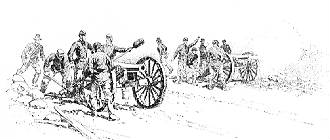
|
| (Battles and Leaders) |
Captain James Hall's 2nd Maine Battery opens fire
on Confederate batteries on the Chambersburg Pike.
Recommended Reading: Gettysburg,
by Stephen W. Sears (640 pages) (November 3, 2004). Description: Sears delivers another masterpiece with this comprehensive study of America’s most studied Civil War battle. Beginning with Lee's meeting with
Davis in May 1863, where he argued in favor of marching north, to take pressure off both Vicksburg and Confederate logistics. It ends with the battered Army
of Northern Virginia re-crossing the Potomac just two months later and with Meade unwilling to drive his equally battered
Army of the Potomac into a desperate pursuit. In between is the balanced, clear and detailed
story of how tens-of-thousands of men became casualties, and how Confederate independence on that battlefield was put forever
out of reach. The author is fair and balanced. Continued below.
He discusses
the shortcomings of Dan Sickles, who advanced against orders on the second day; Oliver Howard, whose Corps broke and was routed
on the first day; and Richard Ewell, who decided not to take Culp's Hill on the first night, when that might have been decisive.
Sears also makes a strong argument that Lee was not fully in control of his army on the march or in the battle, a view conceived
in his gripping narrative of Pickett's Charge, which makes many aspects of that nightmare much clearer than previous studies.
A must have for the Civil War buff and anyone remotely interested in American history.
| Fighting swirls around the McPherson buildings. |
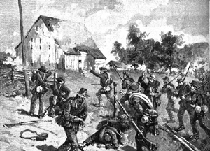
|
| (Battles & Leaders) |
Heth renewed his attack against the Union positions on the McPherson Farm between 1:30 and 2 o'clock. Supported
by Maj. General William Pender's division, Heth sent his two remaining brigades forward to hit a re-enforced line posted behind
strong farm fences and in the woods above Willoughby Run. Doubleday's line was stretched thin, but his division and brigade
commanders shifted troops around to strengthen weak areas of the line. Determined to stand their ground, the Union troops
would not budge no matter how much pressure the Confederates applied. On the McPherson Farm and adjacent Herbst Farm, the
Iron Brigade fought toe to toe with Brig. General James J. Pettigrew's North Carolina Brigade. At
one point in the battle, opposing lines blazed into one another barely twenty paces apart. Two regiments were especially hard
hit- the 24th Michigan Infantry (70% casualties) and the 26th North Carolina Infantry (80% casualties). Twenty one year-old Colonel Henry Burgwyn Jr., commanding the 26th North Carolina, was mortally wounded while leading one
of the last charges against the 24th Michigan. Shot, through both lungs, Burgwyn fell with the Twenty-sixth Regimental Flag
wrapped around him. He was the youngest commanding colonel in Lee's army.
| Robert E. Rodes |

|
| (Miller's History) |
Spread out between York and Carlisle, Pennsylvania, Lt. General Richard S. Ewell's Corps had been ordered
to consolidate in the Gettysburg area on July 1. Setting out early that morning, Ewell's 8,500 troops closed in on Gettysburg
from the north and northeast. Maj. General Robert Rodes' Division was the first to arrive and attacked the right flank of
the Union First Corps on Oak Ridge, the northern extension of Seminary Ridge. The Union troops on Oak Ridge were from a division
commanded by Brig. General John C. Robinson, of the First Corps. Robinson only had Colonel Henry Baxter's brigade of New York,
Massachusetts, and Pennsylvania regiments at his disposal and observing the disjointed Southern attack, shifted his men to
meet each threat upon his position. One by one Baxter's troops repulsed the Confederate assaults and annihilated the North
Carolina brigade commanded by Brig. General Alfred Iverson. Iverson's soldiers marched into an open field unsupported, not
realizing the strength of the Union position behind the stone wall that lay ahead on Oak Ridge. Over 1,100 Union soldiers
rose and fired into the Southerners from less than 100 feet away. Few escaped the terrible fire unscathed. Many surrendered
to Baxter's men as they rushed into the field to take prisoners and capture flags from their fallen bearers.
| John Robinson |

|
| (NY State Archives) |
With Baxter's regiments running low on ammunition, General Robinson called in Brig. General Samuel Paul's
brigade, which replaced Baxter's troops just before General Rodes renewed his attack. Paul's men were soon fighting for their
lives as Rodes shifted regiments from other commands into the attack. General Paul was horribly wounded when a bullet struck
him in the face, passing through both eyes. Remarkably, he survived this horrific wound. Ammunition began to run out. A Confederate
brigade succeeded in reaching woods behind Paul's regiments, threatening to cut them off from the rest of the First Corps.
A retreat was ordered to follow Oak Ridge and rejoin the corps. The brigade withdrew, all except for one regiment, the 16th
Maine Infantry. The Maine soldiers stubbornly held onto their corner of the stone wall and did not leave until the last moment.
Many of the regiment were taken prisoner, including its commander Colonel Tilden. So that their flag would not be taken, the
16th's soldiers ripped the standard into small pieces, each of which was taken by the men.
While Rodes dealt with Baxter and Paul on Oak Ridge, Brig. General George
Doles' brigade of Georgia troops sparred with Schurz's Eleventh Corps positioned in the fields north of Gettysburg. Though
he was outnumbered, Doles' superb generalship kept the Yankee troops, who appeared shaky from the beginning, off guard. Poor
morale, exhaustion, and the exposed position of the Eleventh Corps troops, many who were German and Polish immigrants, contributed
to the disaster about to befall them. Another division of Ewell's infantry under Brig. General Jubal Early, arrived via the
Harrisburg Road at approximately 3 P.M. Understanding the advantage of his position, Early deployed his troops and artillery
so that he could sweep behind the Union line.
A thunderous roar of artillery announced his arrival as ranks of Southern
infantry set out across Rock Creek. Seeing his opportunity, General Doles sent his brigade forward and the two wings of the
Confederate column came together around "Barlow's Knoll". Though some regiments fought with determination, the Confederate
attack broke the line and retreat turned into a panicked rush into Gettysburg. A single Union brigade under Colonel Wladimir
Kryzanowski, a Polish immigrant, attempted to make a stand, but was swept aside by overwhelming numbers. Victorious Confederates
overran the remaining feeble resistance, a small brigade of Union troops under Colonel Charles Coster, and entered Gettysburg.
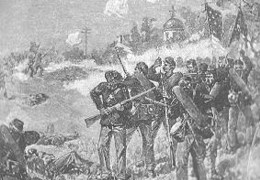
|
| (Battles and Leaders) |
(Right) Picture of Union troops of the First
Corps delay Hill's advance near the Seminary.
West of town, General Doubleday and his First Corps were also in deep trouble. After several hours of fighting
marked by great gallantry on both sides, casualties had whittled down the corps' effective force to less than half of the
Confederates who seemed to continually be sending in fresh troops. Doubleday withdrew his command into a consolidated position
on Seminary Ridge where the men threw down fence rails for a barricade and waited as the Confederates formed on McPherson's
Ridge for a final assault. But driving Doubleday's command from Seminary Ridge proved more deadly than Hill and his division
officers had planned. The initial Confederate attack met a storm of concentrated artillery and musketry fire that nearly destroyed
General Alfred Scales' North Carolina brigade and severely crippled part of a South Carolina brigade commanded by Colonel
Abner Perrin. Outnumbered, low on ammunition and with his rear threatened, there was nothing more Doubleday could achieve
by holding Seminary Ridge. There was no alternative but to retreat through Gettysburg to Cemetery Hill.
The Union line collapses
Despite a severe cross fire and heavy casualties suffered during their charge,
Colonel Perrin's South Carolinians exploited a narrow gap in the Union line and raced onto Seminary Ridge just as the Union
officers ordered their men to pull out. Perrin ordered two of his regiments to pursue the retreating Federals and the incensed
South Carolinians raced after the refugees in blue, taking prisoners and shooting down those who refused to surrender. What
began as an orderly retreat soon turned into a confused race through Gettysburg as soldiers trotted through unfamiliar streets
and alleys while other lost souls ploughed into the crowd from intersecting streets. Adding to the chaos was the lack of orders
to direct the refugees to Cemetery Hill, the Union rallying point. Lost soldiers ran from one street to another to find themselves
confronted by armed Confederates. Others took refuge in cellars and buildings, only to be rooted out and taken prisoner. Wounded
soldiers collapsed in doorways and churches where Gettysburg civilians, such as 21 year-old Sallie Myers, tried to tend to their wounds. Terrified civilians took to their cellars
while above them the floors creaked with the heavy sounds of boots. Rifle shots echoed through the streets. Peering from his
cellar window, one man was horrified by the sight of a Union soldier shot down in the street in front of his home. Everywhere
there were Confederate soldiers with rifles and fixed bayonets, looking for Yankees who had not made their escape.
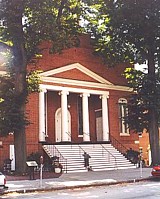
(Left) Christ Lutheran Church on Chambersburg Street was one of the first churches in Gettysburg to be used
as a hospital. Wounded were laid on boards set on top of church pews while operations took place in one of the front rooms.
The monument in front of the church is to Chaplain Thomas Howell of the 90th Pennsylvania Infantry. Confronted by Confederate
soldiers during the Union retreat, Howell refused to surrender his sword and was shot dead on the church steps. Gettysburg NMP.
| W. S. Hancock |

|
| (Miller's History) |
Those who did find their way to Cemetery Hill were confronted by General Winfield Scott Hancock, sent to Gettysburg by General Meade to assume command after the death of Reynolds. Galloping onto Cemetery Hill at 4:30,
Hancock beheld a depressing sight: streets filled with masses of Union troops without order, lathered teams of horses pulling
artillery limbers forcing their way through the crowd, and wounded soldiers limping or staggering along as if drunk. For all
purposes the entire Union force at Gettysburg had been routed. Joined by General Howard, Hancock rode into the center of the
Baltimore Pike and immediately barked orders for officers to rally their commands and find shelter on the hillside. Hancock's
commanding presence and stern demeanor was enough for most of the exhausted soldiers to search for their regiments and fall
into ranks. Hancock paused just long enough to send a report to General Meade before returning to the task of establishing a strong center for the remainder
of the Union line to form upon. By nightfall, reorganized regiments had established a line of defenses from Cemetery Ridge to Culp's Hill with Cemetery Hill at the fortified center.
Once he arrived on the battlefield that afternoon, General Lee appreciated
the advantages gained by the sweat and toil of his troops and gave his consent for the attack to continue. He entered Gettysburg
on the trail of his soldiers, very concerned with the growing Union strength on Cemetery Hill and the adjacent Culp's Hill.
Lee sent a message to General Ewell to take the hills "if practicable"; but Ewell was unable to consolidate his forces to
attack before nightfall and the battered Union troops remained undisturbed throughout the evening. Additional Union troops
arrived to bolster the Union defenses, followed by General Meade who reached the field around midnight. Thanking Hancock for
his services, Meade set about planning for the next day's battle. Though two corps had been defeated and thrown back, their
heroic stance had bought time for the remainder of the Army of the Potomac to close on Gettysburg and camp on a position so
strong that Lee would be hard pressed to break it. Whether he was fully ready or not, Lee had been drawn into battle and Meade
was prepared to fight it to the finish at Gettysburg.
General Lee's headquarters tent was pitched near the Thompson home on the
Chambersburg Pike, an ideal location adjacent to the Lutheran Seminary building where the general could utilize the rooftop
observatory. Seating himself by the light of a candle in his tent, Lee pondered the day's events. Though his soldiers had
driven the Union forces from the field in disarray and captured the town, he certainly had not won the battle necessary to
accomplish all of his objectives in Pennsylvania. Losses in Heth's and Rodes' Divisions had been staggering, but the remainder
of his army was within a day's march, defiantly confident and fit to fight for another day at least. Against his desires,
the ground for the great battle had been chosen and the growing strength of the Union position on Cemetery Hill and Culp's
Hill concerned him. More fighting clearly lay ahead and Lee had to satisfy himself that the hills would be taken the following
day. If only he knew more of where the rest of the Union army was located and how close they were to Gettysburg. That had
been "Jeb" Stuart's job and Lee had not heard from him for almost two weeks.
In more than twelve hours of fighting, nearly 16,000 soldiers were killed,
wounded or captured during the first day of battle.
Recommended Reading: Gettysburg--The First
Day, by Harry W. Pfanz (Civil War America)
(Hardcover). Description: Though a great deal has been written about the battle of Gettysburg,
much of it has focused on the events of the second and third days. With this book, the first day's fighting finally receives
its due. Harry Pfanz, a former historian at Gettysburg National Military Park
and author of two previous books on the battle, presents a deeply researched, definitive account of the events of July 1,
1863.
After sketching the background
of the Gettysburg
campaign and recounting the events immediately preceding the battle, Pfanz offers a detailed tactical description of the first
day's fighting. He describes the engagements in McPherson Woods, at the Railroad Cuts, on Oak Ridge,
on Seminary Ridge, and at Blocher's Knoll, as well as the retreat of Union forces through Gettysburg
and the Federal rally on Cemetery Hill. Throughout, he draws on deep research in published and archival sources to challenge
some of the common assumptions about the battle--for example, that Richard Ewell's failure to press an attack against Union
troops at Cemetery Hill late on the first day ultimately cost the Confederacy the battle.
Battle of Gettysburg History
July 2,
1863 - "A most terrible day..."
The second day at Gettysburg was the largest and costliest of the three
days. The second day’s fighting (at Devil’s Den, Little Round Top, the Wheatfield, the Peach Orchard, Cemetery
Ridge, Trostle’s Farm, Culp’s Hill and Cemetery Hill) involved at least 100,000 soldiers of which roughly 20,000
were killed, wounded, captured or missing. The second day in itself ranks as the 10th bloodiest battle of the Civil War.
| Three days at the place known as Gettysburg |
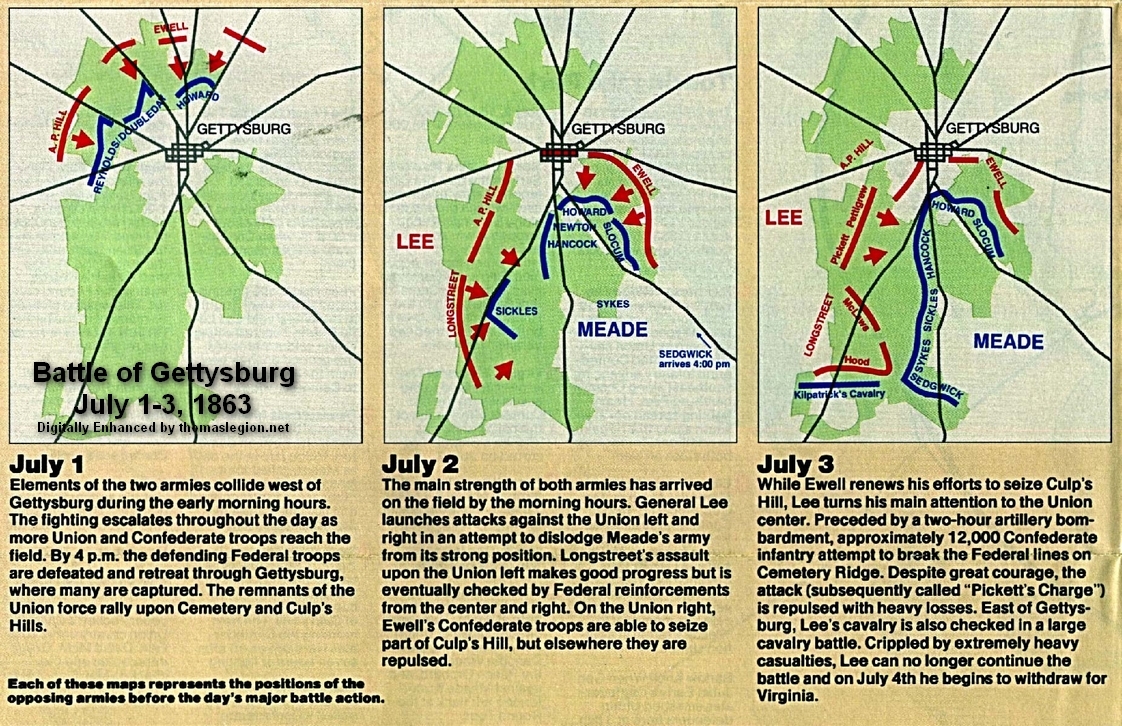
|
| Battle of Gettysburg, July 1-3, 1863 |
| General Meade |

|
| (LOC) |
The Confederate victory on July 1st wasn't conclusive. The Army of the Potomac was still present near Gettysburg and by early morning held a strong position on the hills and ridges south
of town in a horseshoe-shaped line bristling with artillery. With its right anchored on Culp's Hill, the line stretched through Cemetery Hill and southward to a knoll on Cemetery Ridge, north of two hills that locals referred to as the Round Tops. Troops who had arrived overnight were also arrayed
at the base of the smaller of the two hills, partially cleared of tree growth to reveal large boulders and hundreds of rocks,
known as Little Round Top. Despite the loss of Reynolds and the majority of two army corps, Meade was satisfied with his army's position, not only for defense but for an attack as well. Union troops of the Twelfth Corps
east of Culp's Hill may have an opportunity to attack Lee's flank if possible. But as the morning sun peeked through overcast,
rainy skies, the commanding general decided to pull those troops into the horseshoe and wait for Lee to make the next move.
The question was, from which direction would the Confederate attack come? Having sought opinions from his most trusted officers,
Meade decided to bring forward the remainder of his army, repulse any Confederate attack, and if the opportunity arose, he
would, in turn, strike at Lee.
Lee rose before dawn to formulate his plan of attack for the day. In the early
morning light he surveyed the strong Union position and realized that a weakness might lay on the Union flanks. A simultaneous
strike on both the right and left of Meade's position could roll up the Union line toward Cemetery Hill. The weakest flank
was the Union left, which did not appear to be anchored on any high ground including the Round Tops at the southern base of
Cemetery Ridge. After consultation with corps commanders A.P. Hill and James Longstreet, Lee dictated orders that Hill would remain in position at the Confederate center while General Longstreet's Corps would
attack on the right and General Ewell's Corps would strike on the left. Both had to strike at the same time to throw the Union
off balance, not giving Meade time to shift troops to the threatened areas.
| Gen. Longstreet |

|
| (National Archives) |
Ewell's men were close to the field that morning, but James Longstreet's were not. Two divisions of his
corps had stopped for the night several miles away from the field with a third too far away to assist that day. The two divisions
under Generals John Bell Hood and Lafayette McLaws set out at 4 AM that morning but had not yet arrived near Gettysburg while
Lee was formulating plans for an early morning assault. By the time they arrived it was after 8 o'clock, and Lee was forced
to alter his timetable. Orders were finally re-issued at mid morning for General Longstreet to put his troops in motion. Not
thrilled with his assignment because of the unfamiliarity of the ground and his desire to fight defensively, a disgruntled
Longstreet put Hood and McLaws in motion on secondary roads south. After considerable delay, the march began filled with hope
as the early morning drizzle had ended and the sky cleared. Yet misinformation and poor scouting thwarted the march. The day
grew warm and the roads turned dusty under the tramping feet of 16,000 soldiers. Midway to the assigned positions, the lead
scouts discovered that the road crested a ridge where signalmen on Little Round Top could easily spot the Confederate column.
Somehow this critical location had not been reported by Captain Samuel R. Johnston, the officer in charge of an early morning reconnaissance to that area. Longstreet's
men had to counter-march, or retrace their route back to another road that proved a more secluded route toward the southern
tip of Seminary Ridge.
It was not until 3:30 PM when Hood's and McLaws' men finally reached their
positions and formed battle lines having marched an exhausting 18 miles since sunrise. Very few of their troops had the opportunity
to rest or fill empty canteens before the signal guns were fired to begin the assault.
| Daniel Sickles |

|
| (National Archives) |
Situated on the left of the Union line were troops under the command of Major General Daniel E. Sickles
of New York. Despite his lack of military schooling, Sickles was brave, audacious, and had proven himself to be an adequate
brigade commander. In 1863 he was given command of the Third Corps, which he led at the Battle of Chancellorsville, Virginia. Sickles's corps had fought well but were ordered into a position that had a great disadvantage in
ground height. As a result, Confederate artillery had pounded his troops without mercy. On the morning of July 2, Sickles
was worried that the same situation was about to occur. Arriving at Gettysburg overnight of July 1, his troops had been ordered
to occupy the southern end of Cemetery Ridge to Little Round Top. From his position the general worried that the ridge on which ran the Emmitsburg Road would be advantageous
to the Confederates if they held it. Sickles sent several messengers to headquarters that morning requesting that General
Meade visit the Third Corps line to discuss the situation. Meade declined while engaged in other duties. Certain of a Confederate
threat to his front, Sickles finally sent out a strong scouting party that included a regiment of United States Sharpshooters.
Entering Pitzer Woods on Seminary Ridge, the sharpshooters encountered Confederate forces from A.P. Hill's Corps and a brisk
fight ensued. Returning to the Union line, the scouts reported that the woods ahead of Sickles were full of Rebel soldiers
and a dust cloud was seen, obviously caused by a strong column of Confederate troops headed his way. Believing that the Confederate
attack would fall on him from the west, Sickles ordered his corps to advance from Cemetery Ridge and occupy the high ground
at the Emmitsburg Road.
| David Birney |

|
| (LOC) |
The Third Corps was greatly under strength. Sickles had only two divisions, instead of the customary three,
under Maj. General David Birney and Brig. General A.A. Humphreys. As a precaution to cover his left flank, Birney's division
was stretched from the Peach Orchard southeast to Devil's Den. Humphrey's brigades were arrayed in a battle line with supporting columns ready to march up to the Emmitsburg
Road. Though this new line occupied some high ground, it was also very weak; there were not an adequate number of soldiers
to man a solid line, especially on General Birney's front, and the advanced position presented the Confederates with a choice
target to fire upon from two directions. Sickles had moved away from the main Union line on Cemetery Ridge losing the advantage
of artillery support within a shortened front, and, perhaps most condemning, he had made the move forward in defiance of orders
to stay where his corps had been posted. This opened a wide gap on both of his flanks, susceptible to being crushed by a flank
attack- exactly what was about to happen courtesy of James Longstreet.
Longstreet's attack finally began at 4 o'clock when Confederate cannoneers
opened fire on Union positions at Devil's Den and in the Peach Orchard. General Meade had visited Sickles' headquarters a
few moments before and the two were conferring in the Peach Orchard when the Confederate guns opened fire. Despite the precarious
position he was now in, Meade ordered Sickles to stay and fight along this new line and that other troops would be sent to
assist.
| The fighting raged until after nightfall. |
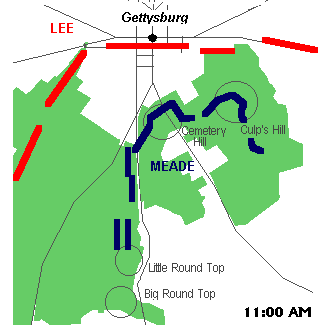
|
| Lee attacked late in the afternoon, striking both Union flanks. |
(Right) Lee attacked late in the afternoon, striking both flanks of the Union position. The issue was in doubt until after nightfall.
| John Bell Hood |

|
| (Miller's History) |
General Hood's Division was the first sent into the attack though the lanky general was unhappy with his assignment. The open farm fields
allowed Union artillery and sharpshooters to pepper his troops long before they reached the opponent's lines. Hood approached
General Longstreet, expressing several objections to the assignment given him and petitioned the general for permission to
withdraw his troops to move around Big Round Top. The corps commander blunted Hood's argument. Lee's orders had to be followed
and Hood had to continue the attack despite his objections. "Do your best, Sam," Longstreet told the obstinate Texan as he
turned his horse away. Law's Alabama Brigade stepped off from Warfield Ridge toward Devil's Den and the Round Tops, closely followed by Brig. General George Anderson's Brigade. Next to
Law's men marched the famous Texas Brigade commanded by Brig. General Jerome B. Robertson. This was General Hood's old brigade
and he paid special attention to them. Riding to the front of his old command, Hood addressed his soldiers: "Fix bayonets,
my brave Texans; forward and take those heights!" Minutes later, General Hood was carried from the battlefield with a horrendous
injury to his left arm. Brig. General Evander Law immediately took command as the troops wrestled their way around Sickles'
left flank at Devil's Den. The Confederates swung eastward through plowed fields and pastures filled with boulders, past broken
fences, and headlong toward Union cannon posted on the ridge above the den, supported by Union infantry. Fighting erupted
on the slopes of Little Round Top, in the Wheatfield, and at the Peach Orchard.
| Little Round Top, photographed soon after battle. |
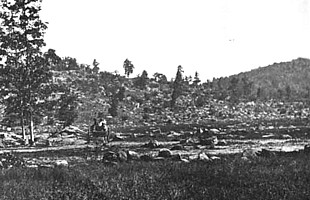
|
| (Library of Congress) |
Reacting to the initial Confederate charge, General Gouverneur K. Warren, Meade's chief engineer, was able
to divert Colonel Strong Vincent's Union brigade to the slopes of Little Round Top. Understanding the importance of the hill,
Vincent posted his regiments on the southern slope where they repulsed the first Confederate attacks. The Southern regiments
re-organized and renewed their efforts to drive Vincent's men from the hillside with repeated attacks. Vincent's line did
not waver, however, and the Union men tenaciously held their ground. Vincent's left regiment, the 20th Maine Infantry under Colonel Joshua Chamberlain, held off the 15th Alabama Infantry for over an hour despite repeated attempts to get behind the Maine regiment and around its flank. With his regiment
having lost heavily and ammunition nearly exhausted, Colonel Chamberlain decided to make a bayonet charge when the next attack
came. The exhausted Alabamians were stopped in their tracks when a line of yelling, cursing men came down the slope at them
with bayonets gleaming in the fading light. It was enough for many who threw down their arms. Others ran for their lives back
into the woods of Big Round Top. Chamberlain approached a Confederate officer whose pistol misfired in the colonel's face,
and accepted the officer's sword in surrender. While the 20th Maine was completing its action in the woods, Vincent's right
regiment, the 16th Michigan Infantry, suddenly began to waver and give way. Screaming the "Rebel Yell", Confederates of the
4th and 5th Texas Infantry rushed up the slope in one final frenzy of shooting, stabbing, and clubbing. Racing to stem the
flow of retreating soldiers, Colonel Vincent was in the act of rallying his soldiers when he was struck down by a Southern
bullet. At this critical moment Union reinforcements spearheaded by the 140th New York Infantry, arrived and halted the Southern
attack. Bravery and gallantry had saved Little Round Top, a key feature on the southern end of the Union line, but at a terrible
cost in officers and men for both sides.
While the fighting raged at Little Round Top and around Devil's Den,
Union troops in the Wheatfield came under attack first from G.T. Anderson's Georgia Brigade, followed soon after by the South
Carolina Brigade of Brig. General Joseph Kershaw. Having left the protection of stone walls on Seminary Ridge, Kershaw's troops crossed the Emmitisburg Road dogged the entire
way by Union cannon stationed in the Peach Orchard. Passing into the Rose Farm, Kershaw realized that his men would have to
face two separate lines of Union infantry, one at the Peach Orchard and the other placed on a stone-covered hill adjacent
to the Wheatfield. Forced to split his brigade in half, the general's left regiments moved against the orchard as his right
marched toward the stony hill. Just behind Kershaw, the brigade of Brig. General Paul Semmes arrived and rushed to support
the South Carolinian's attack. The fighting swirled through the woods surrounding the field as Anderson's troops probed and
moved to outflank the Union forces under Generals DeTrobriand and Barnes. Kershaw's Confederates sought to split the Union
defenders who, though outnumbered, fought back furiously.
| Battle of Gettysburg, July 2, 1863 |
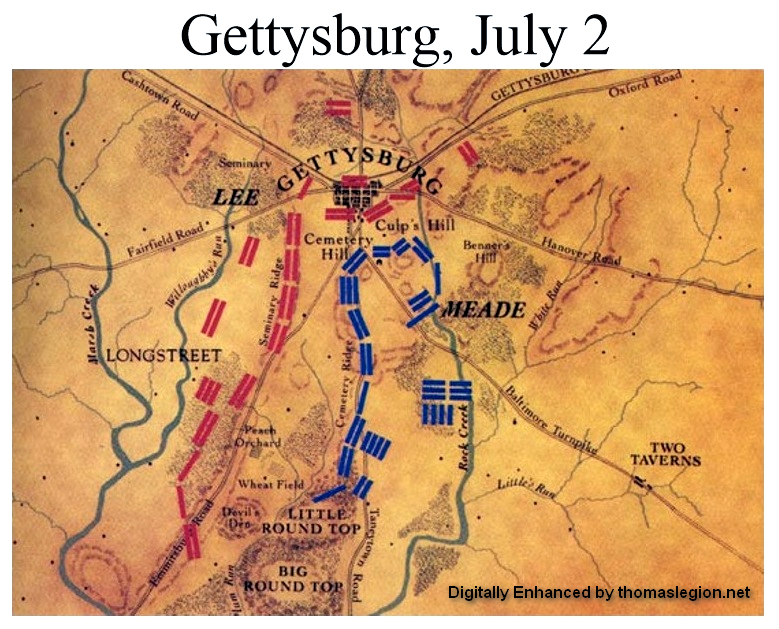
|
| Second Day at Battle of Gettysburg |
| Patrick Kelly |

|
| (CW Library-Philadelphia) |
Reinforcements from the Union Second Corps arrived, including the famous "Irish Brigade" led at Gettysburg by Colonel Patrick Kelly. The total number of Irishmen barely amounted to 500 officers and men. Before
the brigade marched to the Wheatfield, Father William Corby stood upon a large boulder and granted the soldiers complete absolution
at this time of crisis. The New York regiments unfurled their unique green silk flags bearing a golden harp and shamrocks
and followed them southward. Kelly's soldiers were sent into the center of the "whirlpool", charging through the Wheatfield
and into the woods on the west side where they threw back Kershaw's South Carolinians. One soldier recalled finding hundreds
of dead and wounded soldiers amongst the rocks and called out to the unhurt Confederates to throw down their rifles and come
forward. Several did, preferring capture to certain death.
The Second Corps troops were able to clear the Wheatfield of Southerners,
but only for a brief moment. The arrival of a fresh Confederate brigade of Georgia troops commanded by Brig. General William
Wofford, which had just smashed in the last Union defenders at the Peach Orchard, drove into the woods outflanking the Union
positions. The line melted before the Confederate onslaught. Wofford's regiment swept the Wheatfield and aided by men from
Kershaw's, Semmes, and Anderson's brigades, smashed into the division of U.S. Regulars commanded by General Romeyn Ayres,
the last Union soldiers who could stem the Southern tide. Standing their ground, the Regulars suffered terrible casualties
when Confederates were able to sweep around the Union soldiers before they began a fighting retreat across what became known
as the "Valley of Death". Wofford's men raced on to the northern base of Little Round Top where they were suddenly counterattacked
by a brigade of "Pennsylvania Reserves". Led in the attack by General Samuel Crawford, the Pennsylvanians forced Wofford's
men back across the Valley of Death and into the Wheatfield itself. Just before the fighting ended in this area, it had reached
a crescendo in the Peach Orchard and along the Union line north of it.
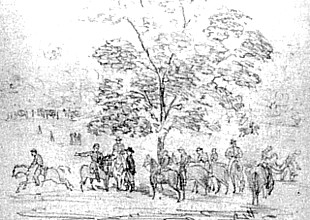
|
| (Library of Congress) |
(Left) General Sickles at his headquarters during the battle, sketched by Charles Reed on July 2, 1863.
From his headquarters at the Trostle Farm, General Sickles attempted to control the flow of the battle while shifting troops to shore up his battered
left. At the height of the battle the general was struck in the leg by a cannon ball and carried from the field on a stretcher.
Despite the tremendous pain and shock, Sickles cheered on other soldiers hurrying to the front. He was taken to a field hospital
where his shattered limb was removed that night. Command of the corps now fell upon General Birney, who knew that the situation
was nearly hopeless. Union artillery at the Peach Orchard persisted in blasting back every Confederate assault, despite a
relentless volume of Confederate iron thrown at them from guns on Seminary Ridge. Hapless infantrymen could only hug the ground
as the missiles filled the air. At approximately 6:30, McLaws sent forward his Mississippi brigade commanded by Brig. General
William Barksdale. The battered Union line collapsed when Barksdale's soldiers rammed through the Peach Orchard, flanking
out Union regiments along the Emmitsburg Road. Barksdale was followed by Brig. General Wofford's Georgia brigade, which swept
on to the Wheatfield, finally clearing it of Union troops. Supported by more Southern brigades from Maj. General Richard Anderson's
Division of Hill's Corps, Barksdale's men charged on, capturing cannon and shooting down Yankees who dared to make a stand.
Before them was a sizeable gap in the Union line between Cemetery Hill and Little Round Top, held by only a handful of Union
batteries and one regiment of Union infantry. Barksdale's men, joined by two brigades from General Hill's Corps, stormed toward
the gap.
On Cemetery Ridge, the 1st Minnesota Infantry was assigned to support
a battery of Union guns when they were ordered to make a desperate charge. Without wavering or questioning the order, Colonel
William Colvill led 262 of his men headlong into Brig. General Cadmus Wilcox's Alabama Brigade, halting them just long enough
for more Union troops to arrive and fill the gap. Adjacent to Wilcox rushed Perry's Florida Brigade, commanded at Gettysburg by Colonel David Lang. Lang attempted to counter
the Minnesotans charge but was in turn ambushed by another Union regiment that fired into the Floridians' flank, driving them
into Wilcox's units. A brisk Union counterattack by a brigade of New York troops under Colonel George L. Willard that drove
back Barksdale now turned on Wilcox and Lang. In danger of being flanked and possibly cut off, Wilcox ordered the two brigades
to retreat, leaving scores of dead and wounded in the path of the charge. An additional Confederate brigade that threatened
the Union line right up to its center was also thrown back, and the sounds of battle slowly died away with the sunset. Darkness
put a grateful end to the slaughter and Meade used the lull to shore up the Union left with troops from the First, Fifth,
and newly arrived Sixth Corps. What was left of Sickles' corps was consolidated with other units on Cemetery Ridge and the
Union line re-established where it had been approximately seven hours before.
The Battle For Culp's Hill
| Edward Johnson |

|
| (Miller's History) |
Delayed by Union artillery and poor communications, the other wing of Lee's army under General Ewell began
the charge onto Culp's Hill at dusk. Confederate infantrymen under General Edward Johnson marched from the Hanover Road to
Rock Creek at the base of Culp's Hill. Overwhelming Union artillery fire from Cemetery Hill had delayed the attack and Johnson
found that the ground he had to cross to reach Culp's Hill broke up his formations, causing more delays to stop and reorganize
before they reached Rock Creek at the base of the hill. In the gathering darkness, Johnson's men waded Rock Creek and pushed
into deep woods where they encountered Union troops under Brig. General George S. Greene. During the afternoon, most of the
Twelfth Corps had been sent from the hill toward the Round Tops to support Sickles' Corps, leaving Greene's troops to hold
the hill. Stationed behind defenses constructed of logs, rocks, and earth, Greene's single brigade of New York regiments was
stretched southward from the summit of Culp's Hill to a small knoll above Spangler's Spring. Johnson's brigades attacked the summit but reeled back under a never ending stream of Union bullets. Farther
south, two regiments of Brig. General George Steuart's Brigade drove back Union skirmishers to find the Union earthworks on
the knoll above Spangler's Spring abandoned.
| Culp's Hill, July 2 & 3 |
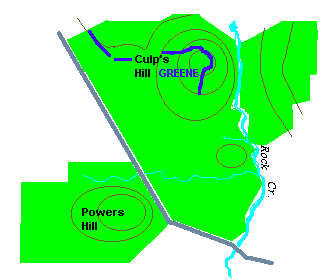
|
| Battle of Culp's Hill |
Steuart attempted to press his units forward but halted when small arms fire hit his regiments from the
summit of the hill and from the woods west of their newly won position. No matter in what direction the general sent his regiments,
they were met with a blinding flash of musketry and forced back to the captured earthworks and stone wall that ran over the
hill. "Our loss was heavy, " General Steuart reported, "the fire being terrific and in part a cross-fire." In the darkness,
General Johnson could not determine his objectives and was uncertain of the force arrayed before him. The determined defense
of Greene's men led Johnson to believe that he was heavily outnumbered. After communicating with General Ewell, he halted
his attack at 11 PM and waited for reinforcements to arrive before renewing the assault at dawn. Though outnumbered almost
three to one, Greene's men skillfully held their positions and fought back small probing parties of Confederates throughout
the night. Additional Union regiments later arrived to support Greene and the echoes of rifle shots finally died away as both
sides attempted to get a fitful few hours of rest before the battle would be renewed.
The Fishhook Almost Breaks: Cemetery Hill
| The Southern charge on Cemetery Hill. |
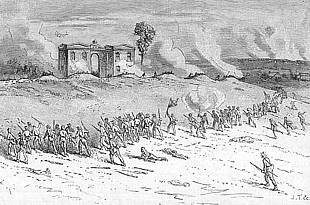
|
| (Battles & Leaders) |
Northwest of Culp's Hill, two Confederate brigades from General Jubal Early's
Division momentarily penetrated the Union defenses at Cemetery Hill. After dusk, Colonel Isaac Avery's North Carolina Brigade
and Brigadier General Harry Hays' Louisiana Brigade, known as the "Louisiana Tigers", charged across the rolling Culp Farm and struck the Union positions at the base of the hill. The nickname for Hays' men
came from former members of the original Louisiana Tigers or Wheat's Battalion, raised in 1861 but disbanded after Major Robert
Wheat's death. The remaining Tigers were transferred into the various regiments of Hays' command where the other Louisiana
soldiers had taken a liking to the nickname and the fame attached to it.
Union artillery sent shrapnel and canister at the dark columns approaching
the hill. Soldiers fell in the corn and wheat, including Colonel Avery who was mortally wounded. Unable to speak, Avery handed
an aide a last message: "Tell my father I died with my face to the enemy." The Northern fire grew in intensity as the Southerners
got closer to the base of the hill where shaken Union regiments from the Eleventh Corps stood poised to resist the attack.
Undaunted, the Southerners rushed the Union line where the 5th, 6th, and 7th Louisiana Regiments overpowered and routed several
Union regiments. Pouring through the gap, the Confederates rushed to the summit of Cemetery Hill and into the Union batteries
stationed there. Though many of the infantrymen scattered, the Yankee artillerymen stuck to their guns defending them with
rammers, trail spikes, pistols, and rocks taken from the nearby stone walls.
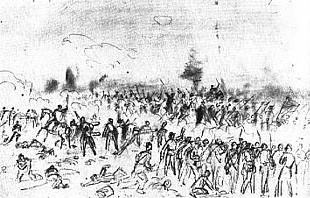
|
| (Library of Congress) |
(Right) Close fighting on Cemetery Hill between Carroll's Brigade and the
"Louisiana Tigers". A sketch made soon after the battle by Alfred R. Waud.
Not quite a quarter mile away, Colonel Samuel Carroll's brigade of the Second
Corps was massed behind Cemetery Ridge when an officer approached with orders from General Hancock: move immediately to the
assistance of the Eleventh Corps on Cemetery Hill. Carroll marched his brigade across farm fields and the Taneytown Road,
and through cemetery where they stumbled into a scene that one officer compared to "a swarm of mad bees around the hive..."
Carroll, "found the enemy up to and in among the front guns of the batteries on the road. It being perfectly dark, and with
no guide, I had to find the enemy's line entirely by their fire." Carroll's three regiments attacked, wading into the mass
of milling soldiers, breaking up the already disordered Confederate formations. An intense hand to hand battle over the Union
guns began. The 6th North Carolina Infantry had planted their regimental flag on one battery but were thrown back by a vicious
bayonet charge of Carroll's command. Several regiments from General Coster's Brigade of the Eleventh Corps joined in the counterattack
and by 10:30, the last Confederates had been thrown off Cemetery Hill. By midnight, the Union line was restored.
While evaluating his army's gains at day's end, a disappointed Lee realized
that his gamble of attacking the Union flanks simultaneously had not paid off. Longstreet's command had taken some high ground
but his losses were very heavy and Meade still held along Cemetery Ridge. The capture of Culp's Hill was still in doubt, though
if it could be secured in the morning, the Union position on Cemetery Hill and the Baltimore Pike would be threatened. Determined
to strike Meade's flank again with as much force as possible the following day, Lee consented to Johnson being re-enforced
and for the attack to continue at first light. By that time he would be able to make a better evaluation of his chances for
success in another attack on the Union flanks or devise another strategy.
Late that evening, the general had a surprise visitor. General JEB Stuart
arrived at Lee's headquarters to report on his success in riding behind the Yankee army and the capture of Federal wagons
and stores. Instead of a warm welcome, Stuart received a cutting reprimand from Lee, upset with the cavalry commander who
had not kept him informed of his movements or the position of the Union army during the past week. A shocked and embarrassed
Stuart attempted to explain, but it had no effect on the old general. Lee's temper finally cooled. "I need you to help me
fight these people," he reminded Stuart, before he changed the subject to his cavalry chief's assignment for the morrow.
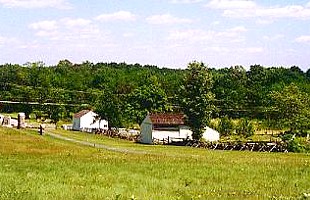
|
| (Gettysburg National Military Park) |
(Right) Photo of Lydia Leister's
Farm, which was used by General Meade for his headquarters during the battle.
General Meade spent the early evening shoring up his line by
shifting troops to threatened areas, including Culp's Hill. It was imperative that the Twelfth Corps be returned to Culp's
Hill to reinforce Greene's New Yorkers and drive out the threat to his rear at first light. Little did the Confederates who
occupied the Union earthworks at Culp's Hill realize that they were only several hundred yards from the Baltimore Pike, the
main route of communication and supply to the Union Army positions. Meade appreciated this fact and knew that measures had
to be taken to block the Confederate opportunity as soon as possible.
Yet there were many issues on the general's mind that evening when he called
his generals together for a "Council of War" held at army headquarters in the home of widow Lydia Leister on the Taneytown
Road. The tiny house had two rooms, one of which was soon crowded with Meade's corps commanders, weary and dirty after the
long day. The generals spoke frankly about the battle so far and discussed the Union positions on Cemetery Ridge. Different
viewpoints were shared until the central question was placed before the group: Should the Army of the Potomac defend their
current position for another day or attack? Almost to a man, the officers agreed to stay at Gettysburg and wait for Lee to
attack. If he did not, then Meade should order a counterattack and force Lee to fight or flee. The Gettysburg Campaign was about to reach its climax.
Recommended Reading: Gettysburg--The Second Day, by Harry W. Pfanz (624 pages). Description: The second day's fighting at Gettysburg—the
assault of the Army of Northern Virginia against the Army of the Potomac on 2 July 1863—was
probably the critical engagement of that decisive battle and, therefore, among the most significant actions of the Civil War.
Harry Pfanz, a former historian at Gettysburg National Military Park,
has written a definitive account of the second day's brutal combat. He begins by introducing the men and units that were to
do battle, analyzing the strategic intentions of Lee and Meade as commanders of the opposing armies, and describing the concentration
of forces in the area around Gettysburg. He then examines
the development of tactical plans and the deployment of troops for the approaching battle. But the emphasis is on the fighting
itself. Pfanz provides a thorough account of the Confederates' smashing assaults—at Devil's Den and Little Round Top,
through the Wheatfield and the Peach Orchard, and against the Union center at Cemetery Ridge. He also details the Union defense
that eventually succeeded in beating back these assaults, depriving Lee's gallant army of victory.
Pfanz
analyzes decisions and events that have sparked debate for more than a century. In particular he discusses factors underlying
the Meade-Sickles controversy and the questions about Longstreet's delay in attacking the Union left. The narrative is also enhanced by thirteen superb maps, more than eighty illustrations,
brief portraits of the leading commanders, and observations on artillery, weapons, and tactics that will be of help even to
knowledgeable readers. Gettysburg—The Second Day is certain to become a Civil War classic. What makes the work so authoritative
is Pfanz's mastery of the Gettysburg literature and his unparalleled knowledge of the ground on which the fighting occurred. His
sources include the Official Records, regimental histories and personal reminiscences from soldiers North and South, personal
papers and diaries, newspaper files, and last—but assuredly not least—the Gettysburg battlefield. Pfanz's career
in the National Park Service included a ten-year assignment as a park historian at Gettysburg.
Without doubt, he knows the terrain of the battle as well as he knows the battle itself.
Battle of Gettysburg, Pennsylvania
July 3, 1863 - "I will strike
him there..."
The third day of fighting would consist of Culp's Hill, Cemetery Ridge, and
two cavalry battles: one approximately three miles to the east, known as East Cavalry Field, and the other southwest of Big
Round Top mountain on South Cavalry Field.
General Lee wished to renew the attack on Friday, July 3, using the
same plan as the previous day: Longstreet would attack the Federal left, while Ewell attacked Culp's Hill. Before Longstreet
was ready, however, Union XII Corps troops started a dawn artillery bombardment against the Confederates on Culp's Hill in
an effort to regain a portion of their lost works. The Confederates attacked, and the second fight for Culp's Hill ended around
11 AM. Lee was forced to change his plans. Longstreet's Assault, more popularly known as Pickett's Charge, would follow. Longstreet
would command Pickett's Virginia division of his own First Corps, plus six brigades from Hill's Corps, in an attack on the
Federal II Corps position at the right center of the Union line on Cemetery Ridge. Prior to the attack, all the artillery
the Confederacy could bring to bear on the Federal positions would bombard and weaken the enemy's line.
Sunset of July 2nd found the Army of
the Potomac arrayed in a fishhook-shaped line anchored solidly along Cemetery Ridge, from Big and Little Round Top to Culp's Hill, the most threatened part of the Union line that evening. Based on the
consensus of officers who attended the Council of War at Meade's headquarters, the Confederate foothold at Culp's Hill
had to be driven off to secure the Union right flank, which covered the Baltimore Pike, the all important road into the Union
rear. General Henry Slocum issued orders for his Twelfth Corps troops to return to Culp's Hill and retake the sections occupied
by General Johnson's Confederate Division as early as possible.
Preparations for the attack were completed and at 4 AM, the Twelfth Corps
counterattacked Johnson's men just as they were preparing to make their own attempt to storm Culp's Hill. Union artillery
posted on the Baltimore Pike and Powers Hill blasted Southern regiments that ventured out of the captured works or pinned
them down so that movement was nearly impossible. Brig. General Alpheus S. Williams, who was placed in command of the corps
by Slocum, sent his regiments into the fighting in waves. Each attack countered every move made by Johnson's men, pinning
them into a tight area above Spangler's Spring and at the base of the hill proper. For six hours the battle on the hillside
raged. The volume of musketry was ear-splitting and the carnage appalling, especially in the meadow near Spangler's Spring.
A misunderstanding of verbal orders caused the 2nd Massachusetts Infantry and 27th Indiana Infantry to charge across the open
meadow where they were caught in a cross fire from Confederates stationed behind stone walls and earthworks. Both regiments
were decimated in the attack. The survivors staggered back to their starting point in the woods south of the field, now littered
with the dead and wounded. Soon after this charge, an attempt was made by the 2nd Maryland Infantry (CSA) and 3rd North Carolina
Infantry to break out of the Union entrapment. The result was as dismal as the Union attempt had been, the Marylanders suffering
heavy casualties in their charge through a small field known today as "Pardee Field", named for Colonel Ario Pardee of the
147th Pennsylvania Infantry whose troops opposed the Southern attack.
The Twelfth Corps had advantages over Johnson's Southerners in holding fortified
positions on the higher portions of the hill, more men and regiments were available to relieve those in the front line, and
Union artillery that provided accurate support to Williams' soldiers. Despite their hold on the hill above Spangler's Meadow,
Johnson's men could not make any headway through the strong Union defenses and had no artillery to support the attack. By
10 o'clock that morning, General Johnson realized that he could not break through or capture Culp's Hill and began to systematically
withdraw his troops, being careful not to give the Union any advantages in counterattacking his retreat. General Steuart,
whose brigade of Maryland and North Carolina troops had held the hill above Spangler's Meadow, was so distraught by his losses
that he broke into tears. "My poor boys," he said, wringing his hands as he watched his exhausted and bloodied men march by,
"My poor boys!"
Union regiments re-took the abandoned positions soon after and General Geary
reported that the rebels had gone from his front. The point of the fishhook was no longer in Southern hands.
General Lee had hoped to again force the Union flanks in the early morning
hours. To coincide with his attacks, he had ordered his cavalry chief, JEB Stuart, to ride around the right of the Union positions
and strike toward Meade's supply line. This disruption would threaten Union supply lines and communications, forcing Meade
to withdraw troops to protect his threatened rear. But delays and the Union counter-attack that resulted in the defeat of
Johnson's command at Culp's Hill, forced a dramatic change in plans. The loss of Culp's Hill left him with few options. Determined
to strike again as soon as possible, Lee threw in his trump card: a grand assault against the enemy center preceded by a massive
artillery bombardment. Believing that Meade had weakened his center to reinforce his flanks, Lee stated that a bold stroke
on the Union center would break the weakest part of the fishhook. The charge would include troops from two corps- an estimated
18,000 men, preceded by a massive bombardment that would sweep the few Union batteries from this section of the Union line.
| Cemetery Ridge |
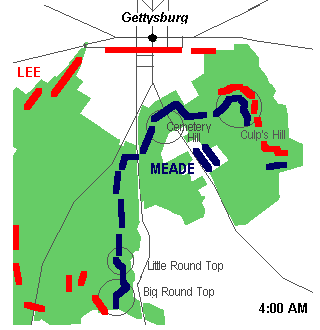
|
| Lee strikes Union center at Gettysburg on July 3, 1863. |
(Right) After the end of the fighting at Culp's Hill, Lee concentrated on breaking the Union center on Cemetery Ridge.
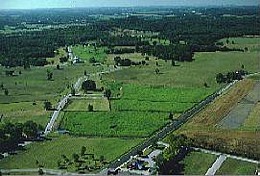
|
| Gettysburg NMP |
(Left) An aerial view of Cemetery Ridge. The Union line stretched from Ziegler's Grove at the lower
left corner, to the Round Tops in the distance. Pickett's Charge broke the center of the line at "The Angle" marked by the
trees in the center of the photo.
General Lee studied the Union line that morning and presented his plan.
General Longstreet was assigned overall command of the attack and ordered to execute the charge. Freshly arrived on the field,
Maj. General George Pickett's Division of Virginia troops would form the right half of the attacking column with two divisions
from A.P. Hill's Corps to form the left half. If all went well, the attack would be carried out before noon though assembling
the required number of men and artillery was another matter. Due to heavy losses suffered on July 1, Hill's six brigades committed
to the assault could only muster about 6,000 men. Combined with the 5,500 under Pickett's command and 1,600 men from Anderson's
Division of Hill's Corps, barely two-thirds of the desired strength was available. By mid-morning, two of Pickett's brigades
were lying in a shallow depression north of the Spangler Farm with the third just behind at the edge of Spangler Woods. Troops
from Hill's corps were arrayed in battle lines behind the trees on Seminary Ridge. Inevitable delays held up the attack and
by noon an eerie silence had descended on the field, broken only by scattered rifle shots of sharpshooters between Gettysburg
and Cemetery Hill. Another hour would pass before all of the preparations were complete.
Late on the morning of July 3rd, Union General Henry Hunt rode to the crest
of Cemetery Ridge. "Here a magnificent display greeted my eyes," he wrote. "Our whole front for two miles was covered by batteries already
in line or going into position. They stretched... from opposite the town to the Peach Orchard, which bounded the view to the
left, the ridges of which were thick with cannon. Never before had such a sight been witnessed on this continent. What did
it mean?"
| E.P. Alexander |

|
| (National Archives) |
Little did Hunt know that this line of approximately 120 cannon was arranged
by General Longstreet to prepare for the greatest charge of the war. In command of the center of the artillery line was 28
year-old Colonel Edward Porter Alexander, whose overwhelming duty was to direct his artillery battalion and judge the effect of the artillery barrage on the enemy
line. Alexander later wrote that his guns were in a "splendid position" to strike Cemetery Ridge, though his primary concern
was for ammunition. The Southern artillery had to achieve good results within the first half-hour for them to properly support
the infantry assault and would require a fresh supply as soon as the infantry advanced. Alexander's commander, Colonel James
Walton, ordered the supply train brought forward to a location near the front lines so that empty ammunition chests could
be quickly replenished.
It was just before 1 PM when General Longstreet sent orders to the Washington
Artillery of New Orleans, stationed in the Peach Orchard, to fire the signal shots to begin the bombardment. The afternoon
calm was broken by two loud booms followed by a violent, simultaneous blast of fire from the solid line of Confederate cannon.
Surprised Union artillerymen ran to their cannon and returned fire. The battlefield shook under the weight of explosions.
Fire and dense smoke covered the ridges and rolled across the fields. Gunners toiled over their heated guns as shells churned
up the earth around them, knocking men and horses to the ground. Caissons and limber chests of two Union batteries erupted
in massive explosions. Alexander anxiously watched the Yankee line through binoculars. It appeared that nothing could live
under the weight of the bombardment on that narrow ridge, but the Union gunfire did not subside; these determined Union cannoneers
simply would not quit. Alexander's fears were proving true; the Confederate guns were not doing as much damage as he had hoped
in the initial attack and with the high rate of fire necessary to suppress the Union artillery, his ammunition chests would
quickly be depleted. Adding to the problem was the poor quality of some Southern-made artillery fuzes and shells, many of
which failed to explode. Inexperienced gunners in several batteries had difficulty aiming their cannon properly and many shells
sailed over Cemetery Ridge into the Union rear, doing little damage to the front line troops and guns. The bombardment continued
toward its second hour when ammunition chests began to empty. Artillery drivers took their caissons to the site where wagons
loaded with extra ammunition were located, only to find them gone. General William N. Pendleton, Lee's artillery chief, had
ordered the wagons away for their protection and didn't inform Alexander or any of his subordinates where they had been sent.
Staff officers rode off to search for the wayward supply wagons as Alexander's gunners began to empty the last level of artillery
shells in the limber chests.
| Henry Hunt |

|
| (U.S.A.M.H.I.) |
General Hunt, who had earlier remarked on the impressive display of Confederate
ordnance, had also prepared the Union artillery line that morning by insuring fresh batteries could be sent forward from the
Artillery Reserve when needed. When his active batteries ran low on ammunition, Hunt could replace them with new units from
the reserve. After forty minutes of constant shelling, those batteries near the center of the line were low on long range
ammunition or partially disabled. Hunt ordered those gunners to cease fire and sent couriers to bring fresh batteries forward.
The Union fire slackened as the guns went silent. Artillerymen in several batteries limbered their smoking guns and prepared
to leave, yet many could not- the tremendous barrage had killed or maimed most of the horses, which lay in heaps in front
of the limbers and caissons still strapped into their harnesses. Through the dense battle smoke, Alexander observed several
Union batteries withdraw and immediately sent a note to General Pickett: "Come quick. The guns in the cemetery have gone.
Come quick or I cannot properly support you." General Pickett immediately reported to General Longstreet in Spangler's Woods and presented Alexander's note. Seated on a fence at the edge
of the woods, Longstreet silently read the note without uttering a word. "Shall I advance, sir?" Pickett asked. The sullen
general could barely nod his approval. Racing to his horse, Pickett mounted and wisped a hasty salute before turning to ride
to his troops. Longstreet remained on his fence quiet and dour, his eyes downcast while his troops moved into position to
begin the mile long march to Cemetery Ridge.
| Battle of Gettysburg, July 3, 1863 |
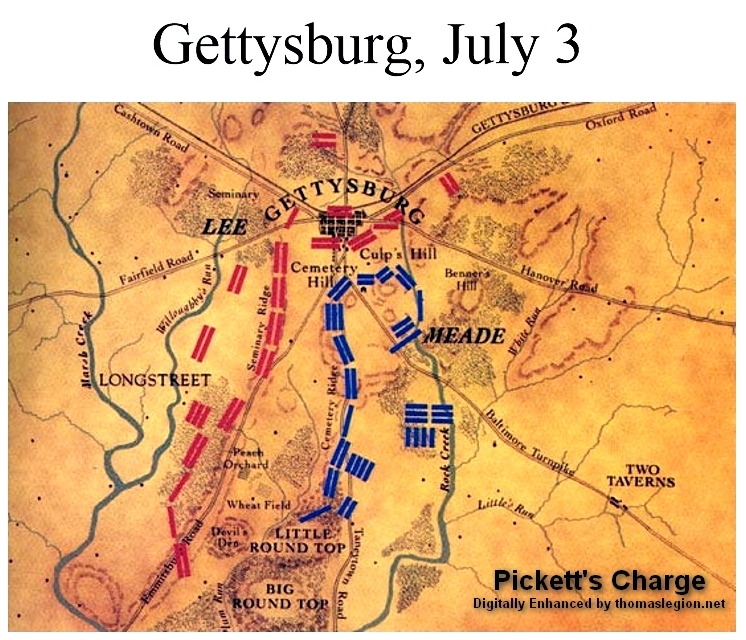
|
| Third Day at Battle of Gettysburg |
| George Pickett |

|
General George Edward Pickett's Division was composed of three brigades of
Virginia regiments. Brig. General Richard Garnett and Brig. General James Kemper led the two brigades arranged in the first
line, with the third brigade, commanded by Brig. General Lewis Armistead, just behind. Lt. J. Irving Sale of Company H, 53rd Virginia Infantry, recalled General Armistead standing at the front of
his old regiment. "Just before we started," wrote Lt. Sale, "he tore off his cravat, put his hat on his sword, and cried:
'Remember your homes, your wives and your sweethearts!'" There were similar addresses by officers of other regiments, yet
the most inspiring words may have come from General Pickett himself who called on his men to remember their homes, "wives
and sweethearts", and the importance of being a native of Virginia. With that, the advance began, the long columns tramping
steadily forward in almost perfect alignment past the Emmitsburg Road and across open farm land toward the smoldering Union
line on Cemetery Ridge.
Almost immediately, Union artillery from Cemetery Hill to Little Round Top opened fire, sending solid shot and shell into the thick, gray-clad columns.
North of Pickett's Division, three lines of Southern infantry emerged from the woods on Seminary Ridge and quickly advanced through the William Bliss
Farm, past the smoking remains of the house and barn which had been burned that morning. The regular commanders of both divisions
having been wounded, Brig. General James J. Pettigrew led Heth's Division, and Maj. General Isaac Trimble led a portion of
Pender's Division. The troops marched in perfect alignment until Union shells hit the left flank of the line where Colonel
John Brockenbrough's small Virginia brigade marched. Nearly shattered on the first day of the battle, Brockenbrough's men
could not stand the fire and fled. General Trimble quickly ordered his two brigades to the left to bolster the wavering line
while Pettigrew continued to urge his men forward.
| John Gibbon |

|
| (Generals in Blue) |
The Union center was held by the Second Corps commanded on July 3rd by General John Gibbon, the same officer who Meade had warned about an attack on his front the
night before. Gibbon realized what this bombardment meant and had done all he could to prepare his infantry who suffered under
the barrage. Many a veteran complained of the frustration of being unable to fight back against an enemy at long range. Some
even expressed a sense of relief to finally see the Confederate infantry emerge from the woods and fields to begin their charge.
At last they would have their chance to fight back.
At the center of Gibbon's line, referred to as "The Angle" for the sharp corner of the stone fence located there, was an infantry brigade of regiments raised entirely
within the county limits and city of Philadelphia. The "Philadelphia Brigade" had fought
with distinction during the Peninsula Campaign (aka Peninsular Campaign), Antietam, and Fredericksburg. Now, they were witnesses to the greatest
charge of the war and would soon find themselves at its center, commanded by an officer unfamiliar to a majority of them.
Brig. General Alexander Webb was given
command of the Philadelphians barely three days before the battle, and had little time to become acquainted with his
officers or men. Yet his troops had fought admirably on July 2nd, and now the astute Webb observed that the charge was headed
toward his position at the Angle clogged with the scattered remains of Battery A, 4th US Artillery, commanded by 21 year-old
Lt. Alonzo Cushing. His battery was still strapped to the limbers and caissons; two of which had exploded from direct hits.
The torn bodies of gunners and drivers lay amidst the scattered equipment and by one of his disabled guns. Despite this destruction,
Cushing asked permission of Webb to remain with his last two operating guns that he ordered be pushed to the stone wall adjacent
to infantrymen of the 71st Pennsylvania. Webb gave his permission to the severely wounded lieutenant, and watched as he and
his few remaining artillerymen pushed the guns forward and piled charges of canister by each. One was manned by volunteers
from the 71st, who jammed rocks and several discarded bayonets into the muzzle of the gun over the canister round. Around
the guns, infantry had taken up and loaded discarded muskets, leaning them against the wall so they could be quickly used.
The grim wait then began as the Southern column appeared, moving steadily forward despite the shot and shell that fell into
their ranks.
Bordering the Emmitsburg Road were stout rail fences, which were too strong
to be knocked down or pushed over, and the Southerners were forced to climb over or crawl through the rails where sections
had not been torn out during the previous day's fighting. The Union line came alive with musketry as Pickett's soldiers scaled
the fences, many of the men taking shelter in the shallow ditches on each side of the road while the rest climbed the next
fence and pushed onward. Armistead's brigade arrived close behind Garnett's men, and immediately scrambled over and through
the unbending obstacle. "I tried to crawl through the fence," recalled Lt. Sale, 53rd Virginia, "and heard the shot striking
ping - ping on the rails all around me. My head got caught between two rails and I recall the horror of the thought that I
might be killed and left hanging there dead. I jumped over the fence and came on. It was awful the way the men dropped."
Those who had weathered the artillery and kept up with their commanders, huddled
behind the regimental flags that danced crazily above the ranks, the color bearers making every attempt to keep their banners
aloft. General Garnett, one of the few officers who rode into the charge, cheered his men forward and up the incline where
the Union line anxiously waited. Randolph Shotwell of the 8th Virginia remembered: "With a shout we start to run up the slope.
Lo! From behind the breastworks on the crest arises a dense rank of blue coats whose polished musket barrels are seen to glitter
for an instant. Then bursts forth a puff, a blinding, withering blaze, a long sheet of lightning as if from the summit of
the hill had suddenly sprung a vomiting volcano. Think of the havoc such a volley must make in the compact columns swarming
up the ascent! All around me were men weltering in their life-blood, some on their faces, some on their backs, some writhing
and moaning, others still forever. Half the flags of the division fell with the first fire, but quickly they were raised by
the survivors and borne forward."
| Lewis Armistead |

|
| (Generals in Gray) |
From behind their stone wall, Gibbon's troops unleashed a merciless fire into
the Southern columns, joined by Union batteries that let loose double charges of canister. With the front of Webb's infantry,
Lt. Cushing was at his single gun, supervising every discharge into the seemingly unstoppable Confederates. "I'll give them
one more shot," he told his sergeant as he took up the lanyard and pulled. The sharp report of the cannon covered the whiz
of the Southern bullet that smacked into Cushing at the same moment, killing him instantly, his lifeless body falling over
the trail of the gun. Out in front, Pickett's men dropped by the hundreds. All organization was lost as the men pushed together
to fill gaps in the ranks, the different regiments soon hopelessly intermingled. Waving swords and shouting commands, officers
encouraged their men onward. The explosion of shells, whine of bullets and rattle of musketry was deafening and commands could
not be heard above the din of battle. All followed the flags forward into the smoke, storming up the gentle slope to the stone
wall at the Angle where Pickett's command intermingled with troops from General Pettigrew's column, and together crashed into
the wall, driving back part of the Union infantry. Hopelessly intertwined, the milling crowd of Southerners hesitated, shooting
at shadows in the smoke ahead and around them. The whine of bullets through their ranks told them that the Union soldiers
had not fully retreated and the area within the angle was a no man's land.
General Webb's troops fought back desperately. Though the 71st Pennsylvania had been forced back from
the wall, they had been joined by the 72nd Pennsylvania, which formed a solid line of blazing musketry at the eastern end
of the Angle. Forcing his way through the crowd, General Armistead approached the front ranks and shouted for the men to follow.
Lt. Sale was right behind the general: "General Armistead was right ahead of me. When we poured over the wall, he waved his
hat and sword and yelled: 'Now give 'em the cold steel, boys!'" Followed by officers and men from his and Garnett's commands,
Armistead leapt the wall and ran to one of the abandoned guns of Lt. Cushing's battery. Lt. Sale and his men followed: "I
was only a few feet behind him when he fell. The next moment I was surrounded and gave up my sword." Once Armistead went down,
the rush forward apparently lost much of its initiative and the men took cover behind the cannon or charged into the dense
thicket of trees nearby, later to be known as the "High Water Mark of the Confederacy."
| The High Water Mark |
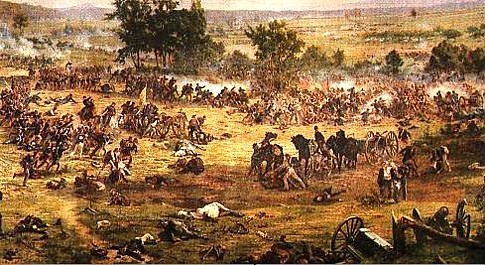
|
Armistead leads his soldiers into the Angle as Union troops
rush forward to stop the breach in the Union line. The "High Water Mark" is the group of trees in the center. From the Gettysburg Cyclorama at Gettysburg National Military Park. (National Park Service)
| A.S. Webb |

|
| (National Archives) |
General Webb had rushed to join his beleaguered regiment, the 69th Pennsylvania, which still held onto their
section of the stone wall as Armistead's Confederates charged into the Angle. Many rushed into the clump of trees to avoid
the deadly musketry coming from the east and turned upon the 69th Pennsylvania, trapped by fallen brush behind and Southerners
swarming along their front. Webb looked behind him to see Southerners shooting into the rear of the 69th and men were hit
from two directions. The regiment's green flag, the color and symbols reflective of the mostly Irish composition of the regiment,
waved in defiance at the mass of red Confederate flags that passed in front. It seemed that Webb's regiment was about to be
swallowed up in a sea of gray when other Union troops rushed into the trees. Just to the southeast of Webb, Colonel Norman
J. Hall saw the breakthrough. His small brigade was positioned on the left flank of Webb's. "The enemy was rapidly gaining
a foothold," Hall reported as he spotted Confederates darting through the trees. Out of the smoke of battle approached General
Hancock who also saw the Confederates and ordered Hall to immediately rush in. Joined by the small regiments of Brig. General
Harrow's brigade, Hall's soldiers crashed headlong into Pickett's men. Harrow's men joined in the attack and the trees were
a compact mass of soldiers loading, shooting, cursing, and bleeding. Men shot and stabbed each other at no more than
ten paces apart. "Organization was mostly lost," Hall remembered. "In the confusion commands were useless... the line closed
with the enemy." This was the high water mark.
"The angel of death alone can produce such a field as was presented."
-
General Alexander Hays
| James Pettigrew |

|
| (Battles & Leaders) |
North of Pickett's command, Pettigrew and Trimble had succeeded in reaching the Emmitsburg Road but with
great difficulty. Union artillery on Cemetery Hill continued to blast the Confederate formations, composed of North Carolina,
Mississippi, Tennessee, and Alabama troops, as they reached the strong fences at the road. Men poured through a handful of
gaps while others scurried over the fences that averaged five and one-half feet in height. With formations lost, herds of
Confederates followed their red battle flags past the road, the right regiments of Pettigrew's line headed toward the angle
to join with Pickett's men while the remainder surged up the gentle slope. Pettigrew's Brigade, commanded by Colonel James
Marshall during the charge, was the center brigade of the front line with the remnant of the 26th North Carolina Infantry
at its center. The survivors of the terrible fighting on July 1st were now in a more deadly situation with nothing to provide
cover or concealment. "The advance was made in perfect order," reported the 26th's commander Major John Jones. "When about
half across the intervening space, the enemy opened on us a most destructive fire of grape and canister. When within about
250 or 300 yards of the stone wall behind which the enemy was posted, we were met with a perfect hail-storm of lead from their
small arms." Knocked down by a spent ball, Jones refused to leave the field until he was certain that the charge had failed
and those who could had escaped. General Trimble had just spoken with Pettigrew by the Emmitsburg Road when he was seriously
wounded, a ball hitting him the leg, shattering the bone. Trimble relinquished command to General Lane and added with his
compliments, "if the troops I've had the honor to command today cannot take those heights, then all hell cannot take them!"
Seconds later general Pettigrew received a painful wound in the hand but remained on the field to rally his men.
| Alexander Hays |

|
| (Generals in Blue) |
Aligned in solid ranks behind stone walls and fence barricades from Ziegler's
Grove to the Angle, troops under the command of General Alexander Hays were more than prepared to contest the Southern attack.
Hays had put two of his largest brigades on the line, stacked shoulder to shoulder. In one place the men were four ranks deep.
Many of these regiments had been forced to surrender to "Stonewall" Jackson at Harpers Ferry in 1862 without firing a shot
and it was a stain that unjustly had followed them since. For many this was the first opportunity to "exact retribution" for
the humiliation. Through the smoke the Union soldiers watched the butternut formations approach, awed by the discipline displayed
in the Southern ranks. The moment was not lost on the fiery General Hays:
"Their march was as steady as if impelled by machinery, unbroken by our
artillery, which played upon them a storm of missiles. When within 100 yards of our line of infantry, the fire of our men
could no longer be restrained. Four lines rose from behind our stone wall, and before the smoke of our first volley had cleared
away, the enemy, in dismay and consternation, were seeking safety in flight. Every attempt by their officers to rally them
was in vain."
| James Lane |

|
| (Generals in Gray) |
Having moved to the left to support Pettigrew's troops, Brig. General James Lane reached the Emmitsburg Road to find his North Carolina brigade on the front line facing a mass of blue-clad
troops at the crest of Cemetery Ridge. "My command never moved forward more handsomely," General Lane reported. "The men reserved
their fire, in accordance with orders, until within good range of the enemy, and then opened with telling effect, repeatedly
driving the cannoneers from their pieces, silencing the guns in our immediate front... We advanced to within a few yards of
the stone wall, exposed all the while to a heavy raking artillery fire coming from the right. My left was here very much exposed
and a column of the enemy's infantry was thrown forward... which enfiladed my line." Lane's troops were trapped in a terrible
cross fire with everyone else in the charge. Soldiers lay down to escape the shower of lead or crawled into any depression
that could provide cover. No one could stand on that field and live.
While Pettigrew's troops struggled for survival, the situation at the Angle
had reached a critical point with the most intense fighting centered on Cushing's wrecked battery. The 72nd Pennsylvania Infantry,
intermixed with members of the 71st Pennsylvania, stood on the crest of the ridge firing into the mass of Confederates who
had retreated back to the wall. Stubbornly refusing to move forward or backward, the "Fire Zouaves" fired wildly into Pickett's
men as rapidly as they could load. Rifle fire and shouts of the combatants were a continuous roar. Lt. Frank Haskell, an aide
to General Gibbon, realized that the regiment had to charge and spurred his horse to the front of the 72nd: "These men of
Pennsylvania, on the soil of their own homesteads, the first and only to flee the wall must be the first to storm it. 'Sergeant,
forward with your color. Let the Rebels see it close to their eyes once more before they die.' The color sergeant of the 72nd
Pennsylvania, grasping the stump of the severed lance in both hands, waved the flag above his head and rushed towards the
wall. Almost halfway to the wall, down go color bearer and color to the ground; the gallant sergeant is dead. The line springs...
with a great roar, heaves forward its maddened load- men, arms, smoke, fire, a fighting mass. It rolls to the wall. A moment
ensues of thrusts, yells, blows, shots and undistinguishable conflict..."
Jammed in the gray-clad crowd at the wall, Lt. John James, Company D, 11th
Virginia, waited in vain for supports to arrive: "We saw the enemy advancing heavy reinforcements. We looked back for ours,
but in vain; we were compelled to fall back and had to run as targets to their balls. Oh, it was hard, too hard to be compelled
to give way for the want of men having fought as hard as we had that day. We gained nothing but glory and lost our bravest
men." A handful of Confederates remained in the clump of trees. "After a few minutes of desperate hand to hand fighting,"
Colonel Hall reported, "the crowd... threw down their arms and were taken prisoner of war, while the remainder broke and fled."
Webb's men pursued the Southerners over the wall. Those who remained had no choice but to surrender. "Defeated, routed, the
enemy fled in disorder," a relieved General Webb reported. "This brigade captured nearly 1,000 prisoners, 6 battle-flags,
and picked up 1,400 stand of arms. The conduct of (my) brigade was most satisfactory. I lost gallant officers and men."
Hundreds of prisoners were herded together, disarmed, and then ordered to
the rear, among them Lt. Sale who had followed Armistead into Cushing's guns. Having surrendered his sword, the young officer
stepped over bodies, "lying all over so thick that you could scarcely help stepping on them." Everywhere soldiers rushed out
to gather up prisoners and the prized Southern flags, many lying abandoned in front the wall, their bearers having been shot
down. One flag was given to the enthusiastic General Hays who rode along the front of his troops dragging the captured banner
through the dust.
Leaderless survivors made their way back to Seminary Ridge. Among them rode
a tearful General Pickett, in shock at the destruction of his once magnificent division. Of the 5,500 men who made the charge,
over 2,800 were killed, wounded, or captured. The survivors were scattered and it took many hours for them to reorganize-
barely a thousand answered to the roll call that evening. Likewise the destruction in Pettigrew's ranks was appalling. A mere
handful reached a point within a few yards of the stonewall, only to be called in to surrender. The remainder turned back
to Seminary Ridge, stepping over and around hundreds of bodies that covered the gentle slope. General Trimble was so seriously
wounded at the Emmitsburg Road that it required the amputation of his leg. Pettigrew was also wounded, struck in the hand
by a canister ball. The storm of Union fire, at one point from three directions, was more than anyone could stand and soldiers
ran for their lives. "We fell back as well as could be expected," added General Lane who's troops were the last off that portion
of the field. The loss in many regiments, including the 11th Mississippi and the 26th North Carolina, was especially frightful.
"It was a second Fredericksburg affair," lamented Captain J.J. Young of the 26th North Carolina, "only the wrong way."
A footnote to the repulse of Pickett's Division was the misguided charge of
Brig. General Cadmus Wilcox's brigade and Colonel William Perry's Florida brigade. By the time Wilcox received word to advance
to support Pickett, smoke so obscured the field that he could not tell where Pickett's troops had advanced to. The two brigades
crossed the Emmitsburg Road following Pickett's original route and charged into a perfect storm of artillery fire in Plum
Run Valley, near the same position where they had fought the day before. Two large Vermont regiments from Brig. General Stannard's
brigade had swung out to hit Kemper's flank and now turned toward the Confederates stuck in the marshy ground of Plum Run.
The 14th and 16th Vermont Infantry Regiments tore into the flank as charges of canister shredded the Southern ranks. For Wilcox,
there was no recourse but a hasty retreat with Pickett's survivors. For the Vermonters, Gettysburg was their only battle.
Stannard's entire brigade was mustered out of service two weeks after the battle and went home heroes, some bearing souvenirs
from their participation in the repulse of Pickett's Division.
While directing the 16th Vermont into position, General Hancock was struck
by a Confederate bullet that traveled through the pommel of his saddle and struck an artery in his groin. A quick thinking
aid applied a tourniquet to stop the bleeding and also pulled a nail from the wound that the bullet had carried from the saddle
into the general's leg. Despite the intense pain, Hancock dictated a final message to Meade, describing the repulse and ending
with the remark that the Confederates must be low on ammunition for he was shot with a ten-penny nail! Gibbon, Webb, and many
others were also wounded, but the center of the line had held.
Union soldiers scoured the field collecting weapons, flags, and the wounded.
General Hays' soldiers collected 2,500 discarded rifles, 15 battle flags, and took over 1,500 prisoners. Sharing in the victory
was the 8th Ohio Volunteer Infantry, positioned far out in front of the Union line on skirmish detail. As the Confederate
line approached Cemetery Ridge and bypassed the Ohioans, Lt. Col. Franklin Sawyer ordered his men to turn and fire into the
flanks of Brockenbrough's and then Scales' and Lane's troops. The apparent confusion in the Southern ranks was so obvious
that Sawyer believed he had turned back the bulk of the Confederate left wing. Sawyer's men charged into the field to capture
approximately 200 Confederates and pick up flags of the 34th North Carolina and 38th Virginia Infantry.
General Meade arrived near the Angle just as the last of Pickett's men were
being driven away. The bombardment had sent he and his staff scurrying from the Leister House to another temporary headquarters,
and he returned just in time to see a herd of Confederate prisoners moving to the rear. "Thank God," the general muttered,
which he followed with a hoarse "Hurrah!" A Union band struck up "Hail to the Chief" as Meade galloped past the bloodied ranks
of soldiers who had held the center. The chant of "Fredericksburg! Fredericksburg!" passed up and down the line. It was six
months before at the Battle of Fredericksburg that these soldiers had experienced an identical trial by fire in a hopeless
charge over open plain. Now they had paid the Confederates back in blood.
For George Gordon Meade, his first test as an army commander had been a successful
one, but the strain of the past week had taken its toll. Outwardly the "old Snapping Turtle" was grateful to his officers
and staff while still irascible with subordinates who did not move quickly enough or brought him bad news. "It was a grand
battle," he confided to his wife in a letter two days later, "and is in my judgement a most decided victory, tho I did not
annihilate or bag the Confederate army. The men behaved splendidly. They endured long marches short rations and stood one
of the terrific cannonading I ever witnessed."
| General Lee |

|
General Lee left his headquarters and rode south on Seminary Ridge to find General Longstreet still seated on the rail fence in Spangler's
Woods. After a brief discussion, Lee rode to Colonel Alexander's artillery line at the edge of the woods, arriving just in
time to witness the Southern tide crest on Cemetery Ridge. Silently he watched the flags disappear in the battle smoke while
hundreds, if not thousands, of his soldiers streamed back toward him. Most walked as if in a trance, others were near panic
and raced as fast as their legs could carry them to safety. Alexander looked at Lee, perhaps curious to see the great commander's reaction. Lee was initially motionless, then quickly sprang into action and rode into the retreating Confederates speaking words of encouragement, thus 'calming
the panicked.' Lee was soon joined by Colonel Arthur Fremantle, a British Army officer who had accompanied Lee's army into Pennsylvania as an observer. To Fremantle, Lee's demeanor in the face of disaster was impressive: "He was engaged in
rallying and in encouraging the broken troops, and was riding about... in front of the woods, quite alone. His face, which
is always placid and cheerful, did not show signs of the slightest disappointment, care, or annoyance; and he was addressing
to every soldier he met a few words of encouragement, such as 'All this will come right in the end; we'll talk it over afterwards;
but, in the meantime, all good men must rally. We want all good and true men just now.' He said to me, 'This has been a sad
day for us, Colonel, a sad day; but we can't expect always to gain victories.' In this manner I saw General Lee encourage
and reanimate his somewhat dispirited troops, and magnanimously take upon his own shoulders the whole weight of the repulse."
For James Longstreet, the dismal failure of the assault was almost too
much. Riding among the survivors, Longstreet encouraged the beaten men to rally themselves behind Seminary Ridge. For "Old
Pete", the failure of the assault would haunt him for the 'rest of his life'. Among the survivors was a downcast General Pickett who rode
silently, pale and in shock. General Lee approached, asking the general the condition of his command. "General, I have no division," Pickett replied. "Armistead is down, Garnett is down, and Kemper is
mortally wounded." Lee responded with kind, comforting words, telling him to rally his men behind Seminary Ridge. Like Longstreet,
Pickett would never forget this terrible moment at Gettysburg and is alleged to have later placed the blame for the failure
of the charge directly on General Lee.
It was soon after rallying his troops that a courier arrived to inform Lee
of Stuart's defeat at the hands of Union cavalry three miles east of Gettysburg. Blocked by a strong Union cavalry force,
Stuart withdrew his cavalry division from the field after a spirited battle. Union cavalry also tested the Confederate right,
still held by General Hood's troops. A charge made by Union cavalry under General Elon J. Farnsworth was handsomely repulsed and resulted in Farnsworth's death.
This was little consolation. Lee knew that he could no longer remain in Pennsylvania.
Late that evening, he dictated orders for his army to withdraw from Gettysburg and begin the retreat back to Virginia.
Recommended
Reading:
Gettysburg--Culp's Hill and Cemetery Hill (Civil War America) (Hardcover). Description: In this companion to his
celebrated earlier book, Gettysburg—The Second Day, Harry Pfanz provides the first definitive
account of the fighting between the Army of the Potomac and Robert E. Lee's Army of Northern Virginia at Cemetery Hill and
Culp's Hill—two of the most critical engagements fought at Gettysburg
on 2 and 3 July 1863. Pfanz provides detailed tactical accounts of each stage of the contest and explores the interactions
between—and decisions made by—generals on both sides. In particular, he illuminates Confederate lieutenant general
Richard S. Ewell's controversial decision not to attack Cemetery Hill after the initial Southern victory on 1 July.
Pfanz also explores other salient features of the fighting, including
the Confederate occupation of the town of Gettysburg, the skirmishing in the south end of town and in front of
the hills, the use of breastworks on Culp's Hill, and the small but decisive fight between Union cavalry and the Stonewall
Brigade. About the Author: Harry W. Pfanz is author of Gettysburg--The First
Day and Gettysburg--The Second Day. A lieutenant, field artillery,
during World War II, he served for ten years as a historian at Gettysburg National Military Park and retired from the position
of Chief Historian of the National Park Service in 1981. To purchase additional books from Pfanz, a convenient Amazon Search Box is provided at the bottom of this page.
Battle of Gettysburg Victory
"The
last full measure of devotion..."
| General Meade |

|
| (U.S.A.M.H.I.) |
After the repulse of Pickett's Charge, General Meade's next dilemma was whether to counterattack Lee while the
Confederate army was in disarray. There were several points to consider- the Union force would need time to get reorganized,
ammunition trains brought forward to replenish empty artillery chests, and fresh units of the Sixth Corps sent forward before
an attack could take place. His troops would have to cross the same mile of open field, now filled with the dead and dying
of Pickett's Division, against Confederate artillery that still had its ample supply of canister. The Confederates had also
pulled together an impressive line of bronze howitzers on Seminary Ridge to meet the expected attack. Deadly at short range,
the howitzers would mutilate the Yankee formations. Meade decided that there had been enough bloodshed for one day. He chose
to hold his current line and then attack Lee at the first opportunity or pursue at the first sign of a withdrawal. The appearance
of dark storm clouds rising from the west also gave Meade reason to delay any assault until after he was reorganized and the
foul weather passed. The Battle of Gettysburg was General George Gordon Meade's victory and the most important ever for the
Army of the Potomac.
Late that evening, the Army of Northern Virginia began preparations for
the long, sad march back to Virginia, which began in dreary, wet weather on July 5. By the following evening, the last Confederates
who could had left the Gettysburg area with the Army of the Potomac soon to follow in close pursuit. The retreat was especially
agonizing for the wounded, packed into ambulances and wagons that bumped and rocked over rough mountain roads to the rain-swollen
Potomac River. Meade followed Lee with caution, finally cornering the Army of Northern Virginia near Williamsport, Maryland.
By the time Meade was set to attack, Lee had slipped over the Potomac River and engineers cut away ropes holding the pontoon
bridges in place. The Confederate army was safely back in Virginia.
The Gettysburg Campaign was over but the agony of the battle was still being
felt in Pennsylvania. Details of Union soldiers and Confederate prisoners spent nearly two weeks combing the battlefield,
interring the remains of approximately 5,500 officers and men from both armies. Gardens became graveyards as hundreds of wounded
soldiers succumbed to their injuries in field hospitals scattered throughout the county. Though the exact number will never
be known, the best estimate of those killed and mortally wounded in the Battle of Gettysburg numbered well over 10,000. Additionally,
the armies left behind approximately 22,000 wounded Union and Confederate soldiers. Churches, barns, and private homes were
filled with injured men treated by a contingent of surgeons, including a number of Confederate surgeons who voluntarily remained
behind when their army left. Gettysburg civilians pitched in to help the injured and dying. Women especially bore the burden
and did all they could to help nurse the wounded, provide food, clothing, water, and anything that could benefit the men in
need.
| Battle of Gettysburg Map |
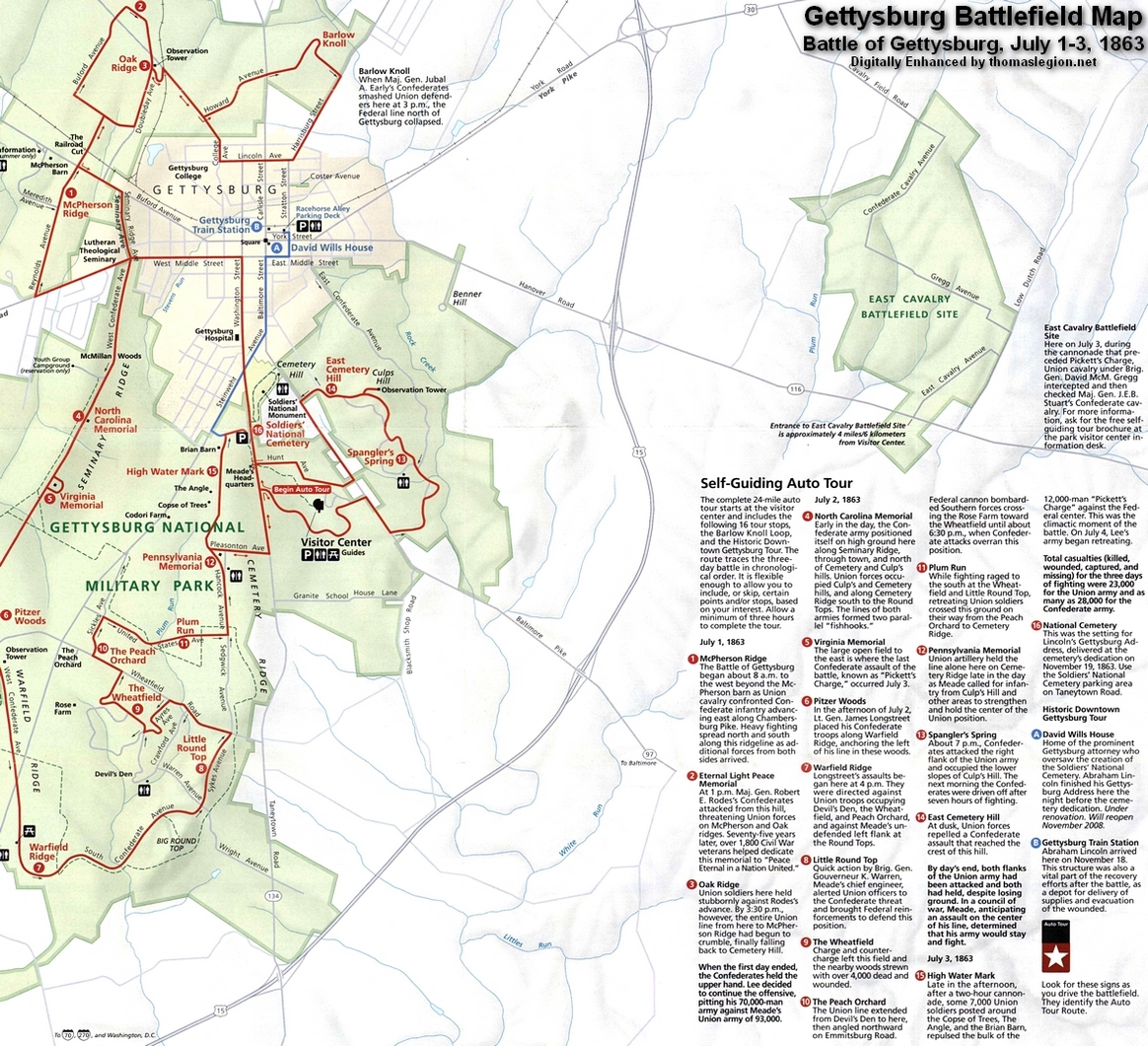
|
| Gettysburg Battlefield Map |
| Surgery at Camp Letterman |

|
| (National Archives) |
Restoration of order in southern Pennsylvania was a priority. The battlefield was designated a Military
District and the 36th and 51st Pennsylvania Emergency Militia Regiments were ordered to Gettysburg to assist with recovery efforts. The militiamen
recovered abandoned military equipment, guarded hospitals and medical stores, and gathered wounded and stragglers. Gettysburg
was also invaded by an army of doctors and specialists of the US Army Medical Department, the United States Christian Commission
and the United States Sanitary Commission. These groups assisted at Union corps field hospitals and at the central hospital
established east of town and named for Dr. Jonathan Letterman, the medical director of the Army of the Potomac. It was at
Camp Letterman Hospital where the injured received a final treatment prior to being sent by rail
to permanent hospitals in Philadelphia, Baltimore, and Washington. At the time it was one of the largest and most efficient
field hospitals ever established.
| Confederate prisoners |
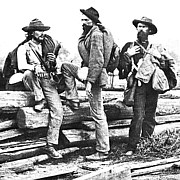
|
| (Library of Congress) |
The multitude of prisoners taken by both armies were also a problem. Over 5,000 captured Confederates were
herded southward on the Baltimore Pike to Westminster, Maryland, where they were transported by rail to Northern prison camps.
A number of Southern prisoners remained in Gettysburg under the watchful eye of the provost guard to assist in burying the
dead and moving wounded to field hospitals. They, too, were eventually sent to Northern prison camps, many to Point Lookout,
Maryland.
Union captives of Lee's army were offered immediate parole, a surprise to
many but reasonable. Lee offered to immediately trade paroled prisoners with Meade as the Confederate commander and his subordinates
did not want to be burdened with columns of prisoners clogging up the roads and having troops appointed to guard them. General
Meade refused stating that such proceedings were not under his jurisdiction, so Lee was left with no choice but to march nearly
4,000 prisoners to Virginia; though some Union soldiers took the parole, most refused. "We knew that we might be a burden
to the rebels and slow them down," wrote one Union captive after the war. Other veterans remembered the hardships of the march
with very little food and guards prodding the men along with bayonets. Once over the Potomac River, the prisoners were sent
to Richmond where many were imprisoned on Belle Isle in the James River or sent to prison camps elsewhere in the South. Though
prisoners of both armies had a chance to be paroled and exchanged as was the custom since 1861, many of the men captured at
Gettysburg would never return to their armies. Suspension of the exchange system in 1864 combined with disease, exposure,
and poor food in the prison camps contributed to the deaths of many. Some sat out the rest of the war as prisoners and were
not freed until long after the cessation of hostilities.
It took months if not years for the people of Gettysburg to recover from the
toll the battle had taken on their lives. Many never recovered. The families who left their homes to escape the fighting returned
to find their livelihoods destroyed. Fields were trampled, livestock destroyed, orchards ruined, fences torn to pieces, their
homes and barns filled with wounded men. Floors, walls, tables and chairs were stained with blood where the surgeon's saw
and probe had done their work. Food stores were decimated. Graves were in every corner of their yards, gardens and fields,
the air foul with the odor of death mixed with the stench of human and animal waste.
The battlefield itself was a dangerous place for many months afterward as
unexploded ordnance remained on the surface or just below ground and more than one Adams County resident was seriously injured
or killed while handling artillery shells. Among the latter was the tragic death of Gettysburg teenager James Culp as recounted
in the Adams Sentinel of September 14, 1863: "A terrible accident occurred on Wednesday evening, in the opening of
a shell found on the battlefield, resulting in the death of James M. Culp, an interesting son of Mr. Daniel Culp, of this
place. The deceased had opened a number of shells without accident, but when at work upon another, near the Cemetery grounds,
the shell exploded, fearfully lacerating his hands and legs, and a piece entering his abdomen. The body was immediately carried
to the residence of his afflicted parents on Baltimore Street - death relieved the sufferer in an hour or so. He was in his
17th year."
Farmers began to rebuild even before the last wounded soldier was removed
from their buildings. Homes and churches in Gettysburg were slowly emptied of wounded, the floors swept and walls scrubbed
clean. Fences and buildings were repaired. Orchards and crops re-planted. Graves began to disappear from the fields as re-interments
took place, or a new growth of grass covered the earthen scar only marked by a simple wooden headboard. Life began to return
to some sense of normalcy after a while but the town of Gettysburg would never be the same again as visitors and the curious
wandered through the borough streets and tramped through the fields where the fighting had been at its worst. For some youths
in town, it was an opportunity to make money as a guide to the battlefield, a profession at which several flourished. The
war had come home to the civilians of Gettysburg and for many it was an experience they never forgot. For one resident named
Daniel Skelly, the scenes of those three days were still vivid many years afterward
when he wrote a memoir of his experiences, as did many others.
In the aftermath of this great campaign, soldiers were quick to write friends
and family to let them know that they were safe and who had been lost. The nation mourned the loss of so many from Northern
and Southern homes. The Southern fighting spirit was not broken, but the results of the battle told heavily on the soldiers
in Lee's army. "Well Lucious," wrote Corporal Jacob Click, 5th Virginia Cavalry, "the army all have crossed back to this side
of Potomac. The army crossed over on last monday night and tuesday morning. I tell you there was a many a poor soldier killed
in Maryland and Pennsylvania and there was no end to the wounded. I think we got the worst end of the barg[a]in this time..."
The National Cemetery
| Dedication ceremonies on November 19, 1863 |

|
| (Library of Congress) |
Soon after the close of the battle, Pennsylvania Governor Andrew Curtin visited
the battlefield. Curtin was appalled at what he saw- destroyed fences and farms, homes full of injured men, graves of the
fallen in every conceivable portion of the field. Heavy rains had washed away the earth from some of the more shallow graves,
exposing hands, arms and legs that stuck out of the ground like "the devil's own planting... a harvest of death." The governor
was not the only Pennsylvanian upset by these conditions. Several patriotic citizens of Adams County undertook efforts to
establish a proper burial site for the Union dead, many of whom lay in unmarked graves where they would soon be forgotten.
An enthusiastic Governor Curtin agreed that the state of Pennsylvania would provide funds to establish the cemetery and help
finance reburials of an estimated 3,600 bodies. Leading the effort for the state was David Wills, a Gettysburg lawyer who
arranged for the purchase of land on Cemetery Hill and improvements of the property. Most fittingly, the Soldiers National Cemetery was established on a part of the battlefield. Landscape architect William Saunders
was hired to design the cemetery and his plan was heralded for its simplicity and equality. Re-interments began that fall.
Union dead were removed from temporary graves and re-buried in state plots in the cemetery, a final resting place for the
defenders of the Union cause.
The cemetery was dedicated on November 19, 1863 and was the occasion of President
Lincoln's highly regarded Gettysburg Address. His two-minute address is known today as one of the greatest speeches of his
presidential career and in American history. The president not only dedicated a cemetery, he gave the North a reason
to continue the struggle to reunite the nation, the focus of the American Civil War.
With the end of the Gettysburg Campaign in mid-July, a stalemate ensued in the east while Union efforts shifted to the
west. Vicksburg fell to Union forces under General Ulysses S. Grant on July 4, 1863. With the
Mississippi River in Union control and the Southern coast blockaded by the US Navy, the Confederacy was surrounded. New Union
attempts to invade Georgia that fall resulted in the Battle of Chickamauga and the eventual siege of Chattanooga, Tennessee.
The siege was broken at the Battle of Lookout Mountain, also known as "The Battle Above The Clouds". In Virginia, the two
armies maneuvered and probed throughout the fall months, with few positive results for either side. An exasperated President
Lincoln looked to his victorious western commander to bring some of that decisive leadership to the armies in the east. The
president had long been searching for a commander with the resolve to fight the battle to a decisive close and he found this
officer in Ulysses Simpson Grant. In 1864, General Grant was given command of all Union forces in the field and he chose to
accompany The Army of the Potomac into the Wilderness of Virginia for a final showdown with Robert E. Lee and his Army of
Northern Virginia. To coincide with this new drive toward Richmond, Grant ordered armies in the south and west to initiate
drives of their own straight into the Deep South. The war lasted another long, bloody year, until April 9, 1865 when it finally
came to an end in the parlor of Wilmer McLean (The McLean House) at Appomattox Court House, Virginia.
Though the years of conflict were over, many more would pass before the United
States was again at peace and fully reunited. What had torn it asunder in 1861 was finally laid to rest and the "new birth
of freedom" of which President Lincoln spoke at Gettysburg became a reality. This landmark battle was recognized for its importance
to the Union cause and the pursuit of a final resolution to the issues which had divided the states. This nation was never
the same after Gettysburg. See also Pennsylvania Civil War History.
(Sources
and related reading below.)
Recommended Reading: Gettysburg, Day Three, by Jeffry D. Wert. Description:
On July 1 and 2, 1863, armies commanded by George Meade and Robert E. Lee clashed in the hilly farm country surrounding Gettysburg, Pennsylvania. Badly
bloodied, the outcome of the battle still uncertain, they fought on into a third day, one whose close would decide the Civil
War. Jeffry Wert, a Pennsylvania high school teacher and well-published scholar of Civil War history, offers a sweeping account
of that third day of battle, one that relies heavily on letters, diaries, and other primary sources. Continued below.
From those
combatants, we learn of the "carnival of hell" that was Pickett's Charge, when "the incessant rattle of musketry sounded like
the grinding of some huge mill." We read of the heroic Union defense of Culp's Hill against equally heroic Confederate attackers,
of a stirring charge of Virginia cavalry that elicited "a murmur of admiration" from opposing Michigan horsemen led by George
Armstrong Custer, and of the exhaustion and terror of ordinary soldiers, one of whom mused, "What men are these we slaughter
like cattle and still they come at us?" Like the battle itself on that final day at Gettysburg,
Wert's narrative unfolds with breakneck speed, and sometimes with so much detail as to yield momentary confusion as it proceeds
from one butchery to the next. Still, his account is painstakingly researched and very well written, and it deserves a place
on the shelf alongside the work of Bruce Catton, Shelby Foote, and other popular historians of the Civil War. --Gregory McNamee
Advance to:
Recommended Reading: Retreat from Gettysburg: Lee, Logistics, and
the Pennsylvania Campaign (Civil War America)
(Hardcover). Description: In a groundbreaking, comprehensive history of the Army of Northern Virginia's retreat from Gettysburg in July 1863, Kent Masterson Brown draws on previously unused
materials to chronicle the massive effort of General Robert E. Lee and his command as they sought to expeditiously move people,
equipment, and scavenged supplies through hostile territory and plan the army's next moves. More than fifty-seven miles of
wagon and ambulance trains and tens of thousands of livestock accompanied the army back to Virginia. Continued below.
The
movement of supplies and troops over the challenging terrain of mountain passes and in the adverse conditions of driving rain
and muddy quagmires is described in depth, as are General George G. Meade's attempts to attack the trains along the South Mountain range and at Hagerstown and Williamsport, Maryland. Lee's deliberate pace, skillful
use of terrain, and constant positioning of the army behind defenses so as to invite attack caused Union forces to delay their
own movements at critical times. Brown concludes that even though the battle of Gettysburg
was a defeat for the Army of Northern Virginia, Lee's successful retreat maintained the balance of power in the eastern theater
and left his army with enough forage, stores, and fresh meat to ensure its continued existence as an effective force.
Recommended Reading: ONE CONTINUOUS FIGHT: The Retreat from Gettysburg and the Pursuit of Lee's Army of Northern Virginia, July 4-14, 1863 (Hardcover). Description: The titanic three-day battle of Gettysburg
left 50,000 casualties in its wake, a battered Southern army far from its base of supplies, and a rich historiographic legacy.
Thousands of books and articles cover nearly every aspect of the battle, but not a single volume focuses on the military aspects
of the monumentally important movements of the armies to and across the Potomac River. One
Continuous Fight: The Retreat from Gettysburg and the Pursuit
of Lee's Army of Northern Virginia, July 4-14, 1863 is the first detailed military history of Lee's retreat and the Union
effort to catch and destroy the wounded Army of Northern Virginia. Against steep odds and encumbered with thousands of casualties,
Confederate commander Robert E. Lee's post-battle task was to successfully withdraw his army across the Potomac River. Union
commander George G. Meade's equally difficult assignment was to intercept the effort and destroy his enemy. The responsibility
for defending the exposed Southern columns belonged to cavalry chieftain James Ewell Brown (JEB) Stuart. If Stuart fumbled
his famous ride north to Gettysburg, his generalship during
the retreat more than redeemed his flagging reputation. The ten days of retreat triggered nearly two dozen skirmishes and
major engagements, including fighting at Granite Hill, Monterey Pass,
Hagerstown, Williamsport, Funkstown,
Boonsboro, and Falling Waters. Continued
below.
President
Abraham Lincoln was thankful for the early July battlefield victory, but disappointed that General Meade was unable to surround
and crush the Confederates before they found safety on the far side of the Potomac. Exactly what Meade did to try to intercept the fleeing Confederates, and how the
Southerners managed to defend their army and ponderous 17-mile long wagon train of wounded until crossing into western Virginia on the early morning of July 14, is the subject of this study.
One Continuous Fight draws upon a massive array of documents, letters, diaries, newspaper accounts, and published primary
and secondary sources. These long-ignored foundational sources allow the authors, each widely known for their expertise in
Civil War cavalry operations, to describe carefully each engagement. The result is a rich and comprehensive study loaded with
incisive tactical commentary, new perspectives on the strategic role of the Southern and Northern cavalry, and fresh insights
on every engagement, large and small, fought during the retreat. The retreat from Gettysburg
was so punctuated with fighting that a soldier felt compelled to describe it as "One Continuous Fight." Until now, few students
fully realized the accuracy of that description. Complimented with 18 original maps, dozens of photos, and a complete driving
tour with GPS coordinates of the entire retreat, One Continuous Fight is an essential book for every student of the American
Civil War in general, and for the student of Gettysburg in
particular. About the Authors: Eric J. Wittenberg has written widely on Civil War cavalry operations. His books include Glory
Enough for All (2002), The Union Cavalry Comes of Age (2003), and The Battle of Monroe's Crossroads and the Civil War's Final
Campaign (2005). He lives in Columbus, Ohio.
J. David Petruzzi is the author of several magazine articles on Eastern Theater cavalry operations, conducts tours of cavalry
sites of the Gettysburg Campaign, and is the author of the popular "Buford's Boys." A long time student of the Gettysburg
Campaign, Michael Nugent is a retired US Army Armored Cavalry Officer and the descendant of a Civil War Cavalry soldier. He
has previously written for several military publications. Nugent lives in Wells, Maine.
Recommended Reading:
General Lee's Army: From Victory to Collapse. From
Publishers Weekly: You cannot say that University of
North Carolina professor Glatthaar (Partners in Command) did not do his
homework in this massive examination of the Civil War–era lives of the men in Robert E. Lee's Army of Northern Virginia.
Glatthaar spent nearly 20 years examining and ordering primary source material to ferret out why Lee's men fought, how they
lived during the war, how they came close to winning, and why they lost. Glatthaar marshals convincing evidence to challenge
the often-expressed notion that the war in the South was a rich man's war and a poor man's fight and that support for slavery
was concentrated among the Southern upper class. Continued below.
Lee's army
included the rich, poor and middle-class, according to the author, who contends that there was broad support for the war in
all economic strata of Confederate society. He also challenges the myth that because Union forces outnumbered and materially
outmatched the Confederates, the rebel cause was lost, and articulates Lee and his army's acumen and achievements in the face
of this overwhelming opposition. This well-written work provides much food for thought for all Civil War buffs.
Recommended Reading: Gettysburg: A Testing of Courage. Description: America's Civil War raged for more than four years, but it is the three days of fighting in the Pennsylvania countryside in July 1863 that continues to fascinate, appall, and inspire new
generations with its unparalleled saga of sacrifice and courage. From Chancellorsville, where General Robert E. Lee launched
his high-risk campaign into the North, to the Confederates' last daring and ultimately-doomed act, forever known as Pickett's
Charge, the battle of Gettysburg gave the Union army a victory that turned back the boldest and perhaps greatest chance for
a Southern nation. Continued below.
Now, acclaimed
historian Noah Andre Trudeau brings the most up-to-date research available to a brilliant, sweeping, and comprehensive history
of the battle of Gettysburg that sheds fresh light on virtually every aspect of it. Deftly balancing his own
narrative style with revealing firsthand accounts, Trudeau brings this engrossing human tale to life as never before.
Recommended Reading: Hallowed Ground: A Walk at Gettysburg, by James M. Mcpherson (Crown Journeys) (Hardcover). Review From Publishers
Weekly: The country's most distinguished Civil War
historian, a Pulitzer Prize winner (for Battle Cry of Freedom) and professor at Princeton,
offers this compact and incisive study of the Battle of Gettysburg. In narrating "the largest battle ever fought in the Western Hemisphere," McPherson walks readers over its presently hallowed ground, with monuments numbering
into the hundreds, many of which work to structure the narrative. They range from the equestrian monument to Union general
John Reynolds to Amos Humiston, a New Yorker identified several months after the battle when family daguerreotypes found on
his body were recognized by his widow. Indeed, while McPherson does the expected fine job of narrating the battle, in a manner
suitable for the almost complete tyro in military history, he also skillfully hands out kudos and criticism each time he comes
to a memorial. Continued below.
He
praises Joshua Chamberlain and the 20th Maine, but also the 140th New York
and its colonel, who died leading his regiment on the other Union flank in an equally desperate action. The cover is effective
and moving: the quiet clean battlefield park above, the strewn bodies below. The author's knack for knocking myths on the
head without jargon or insult is on display throughout: he gently points out that North Carolinians think that their General
Pettigrew ought to share credit for Pickett's charge; that General Lee's possible illness is no excuse for the butchery that
charge led to; that African-Americans were left out of the veterans' reunions; and that the kidnapping of African-Americans
by the Confederates has been excised from most history books.
Sources: Gettysburg National Military Park;
Library of Congress; National Archives and Records Administration; National Park Service; Official Records of the Union and Confederate Armies.
|

